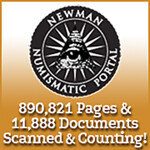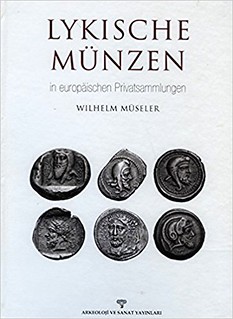
About UsThe Numismatic Bibliomania Society is a non-profit organization devoted to the study and enjoyment of numismatic literature. For more information please see our web site at coinbooks.org SubscriptionsThose wishing to become new E-Sylum subscribers (or wishing to Unsubscribe) can go to the following web page link MembershipThere is a membership application available on the web site Membership Application To join, print the application and return it with your check to the address printed on the application. Print/Digital membership is $40 to addresses in the U.S., and $60 elsewhere. A digital-only membership is available for $25. For those without web access, write to: Terry White, Treasurer
AsylumFor Asylum mailing address changes and other membership questions, contact Terry at this email address: terrywhite5475@yahoo.com SubmissionsTo submit items for publication in The E-Sylum, just Reply to this message, or write to the Editor at this address: whomren@gmail.com BUY THE BOOK BEFORE THE COINSale Calendar |
- WAYNE'S WORDS: THE E-SYLUM MARCH 12, 2017
- NEW BOOK: LYCIAN COINS
- NEW BOOK: MEROVINGIAN COINS
- NEW BOOK: AMERICAN JOURNAL OF NUMISMATICS, V28
- NEWMAN PORTAL INTRODUCES ADVANCED SEARCH
- NOTES FROM E-SYLUM READERS: MARCH 12, 2017
- MORE ON THE THREAT OF COLLAPSING BOOKSHELVES
- JEFF BURKE'S NUMISMATIC DIARY MARCH 12, 2017
- THE COINS PLACED ON LINCOLN'S EYES
- VOCABULARY TERM: CLIPPED PLANCHET
- FRANK M. PINKERTON (1871-1930)
- MAXIMILIAN SALMON (1857-1925)
- DWIGHT MANLEY MOVIE POSTER EXHIBIT
- VIDEO: U.S. MINT SCULPTOR JOSEPH MENNA
- FAKE CALIFORNIA FRACTIONAL GOLD COINS
- SELECTIONS FROM THE MARCH 2017 KAGIN'S SALE
- HOLABIRD MARCH 25 WESTS TOKEN SALE
- NUMISMATIC NUGGETS: MARCH 12, 2017
- KRALJEVICH ON POGUE COLLECTION, PART V
- SELECTIONS FROM THE POGUE COLLECTION, PART V
- BUILDING THE LILLY COLLECTION, CONTINUED
- GLENNA GOODACRE SCULPTURAL WORKS FOR SALE
- KUSHAN DYNASTY COINS BAFFLE EXPERTS
- THE NETHERLANDS: “LION DAALDER” REBORN
- STOLEN BANKNOTE RETURNED 30 YEARS LATER
- DEMAND CONTINUES FOR SPECIAL FIVE POUND NOTES
Click here to access the complete archive
To comment or submit articles, reply to whomren@gmail.com
Content presented in The E-Sylum is not necessarily researched or independently fact-checked, and views expressed do not necessarily represent those of the Numismatic Bibliomania Society.
WAYNE'S WORDS: THE E-SYLUM MARCH 12, 2017
New subscribers this week include: Martin Baer, Erv Brauer, Matt Lenore, and N. Butler. Welcome aboard! We now have 2,809 subscribers.
Thank you for reading The E-Sylum. If you enjoy it, please send me the email addresses of friends you think may enjoy it as well and I'll send them a subscription with your compliments. Contact me at whomren@gmail.com anytime regarding your subscription, or questions, comments or suggestions about our content.
This week we open with three new books, a search upgrade from the Newman Numismatic Portal, notes from E-Sylum readers and a nice numismatic diary entry from Jeff Burke.
Other topics this week include the coin placed on President Lincoln's eyes, U.S. Mint sculptors Joseph Menna and Glenna Goodacre, the Pogue collection, Lion dollars and Maximilian Salmon.
To learn more about Merovingian coinage, Arabic numerals and dates, the BEP's Hydrostatic Press Room, overloaded bookshelves, Matthew Young's token, extreme clipped planchets, Dwight Manley's other collection, the 1946 United Nations Monetary Patterns, and the Amon Carter 1801 Dollar, read on. Have a great week, everyone!
Wayne Homren
Editor, The E-Sylum

NEW BOOK: LYCIAN COINS
The author has an exceptionally large number of ancient coins from Lycia, located in various German and Western European private collections at the present time, recorded and cataloged. The ensemble, which is created in this way contains not only a number of previously unknown pieces but overall it is more extensive and diverse than all previously published collections of coins of this type in private or museum-owned.
When compiling the coins therefore numerous references and links between various series have become visible that were previously undetected. These compounds have enabled the author to reconstruct the chronological and topographical context in which the relevant issues should be classified. As a result, while a new perspective on the political geography of Lycia in the 5th and 4th century v. Chr. Developed, which brought a number of additional details to light and in some ways different from previous interpretations.
A comparison of obtained from the analysis of the numismatic holdings findings with the results of archaeological and especially the epigraphic research in Lycia has led to a whole series of new results and questions that discussed in the introductory essay entitled "Lycian coins and inscriptions" be: This is among other things to the allocation and dating of the inscriptions on the famous pier grave at the Agora of Xanthos to the question of the authorship of such important buildings as the Nereids monument or Heroon of Trysa and to many other important problems of history Lycia in question period ...
For more information, or to order, see:
https://www.amazon.com/Lykische-M%C3%BCnzen-europaischen-Privatsammlungen-Wilhelm/dp/6053964212
The book is divided into two parts: An introduction and a catalogue part. In the 71(!) pages of “introduction”, Wilhelm Müseler gives an account of his notion of the Lycian history of money. He does so mostly by means of the coins, which he analyses in great detail. This includes chapters on weight standards, the legends, the images and the mintmark. Regarding chronology, although he offers his own solutions for some eras, he mostly follows Novella Vismara and the chronology she has worked out for the collection Winsemann-Falghera. This truly extensive “introduction” ends with the historic conclusions, in which Wilhelm Müseler reconstructs the history of Lycia based on the coins as far as possible. He does it thoroughly, knowledgeably, sometimes a bit apodictically and with an exuberant delight in academic controversy.
For the coin trade, the catalogue will be the most useful part of the book, especially because it entails numerous coins, which often turn up in trade but never in the relevant publications of museum collections. The division of the catalogue into chapters follows the chronology. Every single coin is described with all data relevant for catalogue creation: Minting dynast, minting city, denomination, approximate date and – when dynasts are concerned – the assumed mint. In addition, Müseler gives a detailed description and quotes the corresponding literature, if provided, names the weight and the auction where the piece was sold. It is obvious that Wilhelm Müseler has written many coin catalogues in his life and knows, which data is needed. One piece of information is missing though – in which collection the coin can be found today.
To read the complete article, see:
Lycian coins (www.coinsweekly.com/en/News/Lycian-coins-/4?&id=4574)
THE BOOK BAZARRE
NEW BOOK: MEROVINGIAN COINS
RTSENA 7
Philippe Schiesser
MONNAIES ET CIRCULATION MONÉTAIRE MÉROVINGIENNES
(vers 670 – vers 750)
LES MONNAYAGES D’ARGENT DE TOURAINE
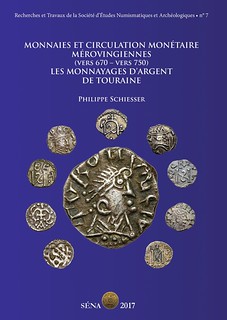 Why write a book about Merovingian coinage, when according to popular belief it was so rare? Moreover, why limit this book to the age of silver (ca 670 - 750)? In fact, these coins are
now known in significant numbers. If for instance we consider only the coins minted in Touraine (that is to say, the département of Indre-et- Loire), the catalogue below lists more than 250 coins,
including 25 bracteate oboles (half deniers), all of them illustrated. This figure includes more than 130 deniers of a type which was undoubtedly minted in Touraine. In addition, over 100 deniers
bearing a large globule and a pentalpha include a number definitely struck in or near Tours, since they bear the mint name Saint Martin, although it is uncertain whether this refers to Tours or
Chinon. The latter type is the only one for which oboles are known. Another 50 or so deniers which were not minted in Touraine but which have previously been attributed to the region have also been
included in the study, and a number of these reassigned to Quentovic, Maastricht or Troyes.
Why write a book about Merovingian coinage, when according to popular belief it was so rare? Moreover, why limit this book to the age of silver (ca 670 - 750)? In fact, these coins are
now known in significant numbers. If for instance we consider only the coins minted in Touraine (that is to say, the département of Indre-et- Loire), the catalogue below lists more than 250 coins,
including 25 bracteate oboles (half deniers), all of them illustrated. This figure includes more than 130 deniers of a type which was undoubtedly minted in Touraine. In addition, over 100 deniers
bearing a large globule and a pentalpha include a number definitely struck in or near Tours, since they bear the mint name Saint Martin, although it is uncertain whether this refers to Tours or
Chinon. The latter type is the only one for which oboles are known. Another 50 or so deniers which were not minted in Touraine but which have previously been attributed to the region have also been
included in the study, and a number of these reassigned to Quentovic, Maastricht or Troyes.
The study examines all the known coin finds from this period in Touraine, including not only deniers and oboles but also contemporary foreign coins (sceattas and thrymsas represent 4.3 % of the single finds). Nearly a hundred single finds are listed, as well as the 45 coins in the Savonnières hoard, giving an overall total for the county of 132 deniers and 7 oboles (7.5 % of the single finds).
It is thus no longer possible to consider Merovingian silver coins as rare or unusual. They are found in large numbers of various different types, and the list of surviving specimens continues to grow.
The historical context of the region is also discussed, together with the issue of who minted coinage at this time. The range of authorities and their distribution across the whole of the region will become clear, even if fewer places are named on the coins than in the preceding period, when the coins being minted were gold.
The minting of coins in Touraine seems to follow a pattern that can also be observed in other mints. The coins brought together here reveal that there was an important visual continuity between the various successive types. It was evidently judged desirable not to alarm the public by dramatic changes, and instead to facilitate the circulation of new types by retaining stylistic similarity. The earliest silver coins are the ‘large deniers’ (16-17 mm). They belong to a series marking the transition from gold to silver: the same phenomenon can be seen at, for example, Reims. Coins of one and the same type are found in both metals, and in certain cases they are even from the same moneyer or in the same style. One of the types bears a complex monogram which is also found on a denier of standard size (11-12 mm) in the name of the same moneyer. The monogram subsequently becomes simpler and is used across the different mints of the region, such as for example Amboise and Bourgueil. The introduction of the type bearing a large globule in a beaded circle and pentalpha seems to mark a break with tradition. Nonetheless, it is present in the Savonnières hoard among others, and it is only the disappearance of the portrait which is truly novel. The transition from Merovingian to royal Carolingian coinage at Tours is marked by stylistic continuity in the form of the retention of the type with a large globule in a beaded circle. Again, the same phenomenon can be observed at other mints.
The links between the different coinage types allow us to establish a relative chronology. The Touraine types are found in large numbers in certain hoards but not at all in others, without this apparently corresponding to any clear logic. It is therefore not possible to establish an absolute chronology.
The geographical distribution of the finds in Touraine clearly shows continuity in the use of coin in secondary Roman settlements. Only a small number of coin finds are recorded in the capital city, Tours, even though it was the primary mint at this time. A larger number of finds are known along the Loire and the Vienne, and there is a significant concentration in the area between these two rivers.
The large number of coins, and particularly the fact that for so many both the mint and the find spot are known, makes it possible to plot monetary circulation at the time. Around half of the Merovingian silver coins were found less than a hundred kilometres from where they were minted, and almost all the coins ended up within three hundred and fifty kilometres of their mint, irrespective of whether they were minted or discovered in Touraine. This brings out the fact that there were three principal currency pools during this period. One consisted of central Gaul, including Touraine. The second was in the north, where Frisian, British and Merovingian sceattas circulated, and the third corresponds to the patriciate of Provence. Circulation was thus apparently predominantly regional.
This makes it easier to understand how the type bearing a large globule in a pelleted circle and a pentalpha could have been minted in at least two different cities. It benefitted from the limited circulation within these currency pools, which made it easier for this easily recognisable type to be accepted. Touraine lay at the heart of the central Gaul zone. It is the only region in which mints are known to have struck bracteate Merovingian oboles (at Touraine, Melle, Poitiers, Bourges, and perhaps also Orléans). From the Carolingian period bracteate oboles are known from Melle, Angers and Saint-Maixent (Deux-Sèvres). The distribution map of finds of Merovingian deniers from Rennes and Paris, together with French hoards, confirm the existence of this regional currency pool in central Gaul, which included Neustria and northern Aquitaine. Where this zone ended to the south is unclear. The Plassac hoard seems an isolated case, and only two or three deniers are known from Bordeaux. However, Melle and Poitiers undoubtedly formed part of this central Gaul pool.
Another currency pool, further to the north, is that of the sceattas, effectively another name for deniers. The border between the zone where sceattas dominated the currency and that where central Gaulish deniers were in circulation was, according to Michael Metcalf and Wybrand Op den Velde, ‘an imaginary line between Le Havre and Liège / Maastricht’. This line takes into account the location of the northernmost Merovingian mints, and is just under three hundred and fifty kilometres north of Tours. The reattribution of certain sceattas to Quentovic means that this zone included the whole of northern France.
The patriciate of Provence appears to have formed a third currency pool, in which no bracteate oboles were minted. The Nice-Cimiez hoard, like that from Savonnières, gives the impression of limited regional circulation, in that it is almost exclusively composed of coins minted in the Provencal patriciate. Coins of the Marseille mint alone account for over three-quarters of the hoard.
Certain circulation patterns are apparent within the central Gaul currency pool. Coins from Aquitaine, struck from silver mined in Melle, follow the river Vienne northwards and feed into Touraine. Meanwhile coins from Touraine make few inroads into Aquitaine and are primarily found to the north, that is, in Neustria and the Loire valley. Some specimens even travelled as far as England and northern Germany. Distribution maps show clear signs of a flow of coin from the south to the north, following the rivers.
The very large number of coin finds and various references to payments in silver show that coinage was used to a greater extent in this period than has generally been recognised. The minting of oboles, half pennies, also demonstrates the need to have a lower denomination currency for everyday transactions. There was undoubtedly a significant monetary economy during the first half of the 8 th century, at least in the region where oboles were being minted, near the mine at Melle, in the heart of the central Gaulish currency zone.
This volume thus profoundly changes the traditional picture of the coinage and level of monetization of the Merovingian age of silver (ca 670 - 750).
Available on the site of the publishing association www.sena.fr
For more information, or to order, see:
http://www.sena.fr/
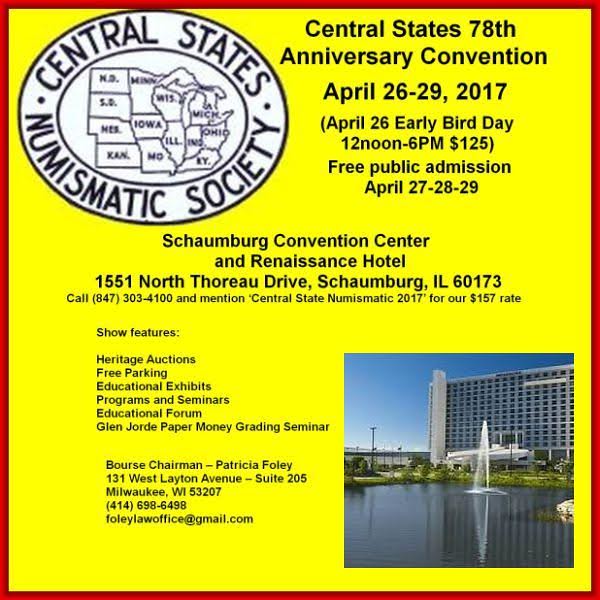
NEW BOOK: AMERICAN JOURNAL OF NUMISMATICS, V28
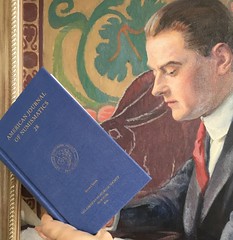 The American Numismatic Society is proud to announce the arrival of the American Journal of Numismatics, Vol. 28. Subscribers will receive their copies the week of March 6, 2017. This
volume contains 271 pages, 60 b/w plates, and seven articles, plus a book review:
The American Numismatic Society is proud to announce the arrival of the American Journal of Numismatics, Vol. 28. Subscribers will receive their copies the week of March 6, 2017. This
volume contains 271 pages, 60 b/w plates, and seven articles, plus a book review:
“Seleukos I’s Victory Coinage of Susa Revisited: A Die Study and Commentary,” by Laure Marest-Caffey
“The Reactions of Mint Workers to the Tumultuous Second Reign of Demetrius II Nicator,” by David Schwei
“The Koinon of Athena Ilias and its Coinage,” by Aneurin Ellis-Evans
“The Coin Hoards of the Roman Republic Database: The History, the Data, and the Potential,” by Kris Lockyear
“Notes on the Early Medieval Numismatics of Central Asia,” by Michael Fedorov
“The Administration of the ‘Abbasid North and the Evidence of Copper Coins (AH 142–218/AD 759–833,” by Aram Vardanyan
“Ancient Roman Colonial Coins in Renaissance Europe,” by Damiano Acciarino
Review Article: Alain Bresson reviews Aux origines de la monnaie fiduciare: traditions métallurgique et innovations numismatiques. Actes de l’atelier international des 16 et 17 novembre 2012 à Tours (Catherine Grandjean and Aliki Moustaka, eds.).
If you are not a subscriber, but would like to purchase a copy for US$75.00 plus shipping, please contact Catherine DiTuri.
AJN 29 is currently in production, and will ship to readers before the end of 2017.
To read the complete article, see:
AMERICAN JOURNAL OF NUMISMATICS VOL. 28 (http://numismatics.org/pocketchange/ajn28/)
NEWMAN PORTAL INTRODUCES ADVANCED SEARCH
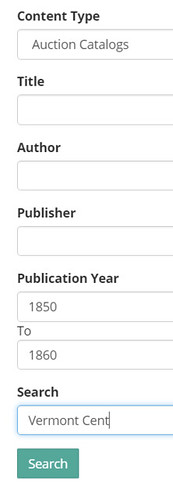
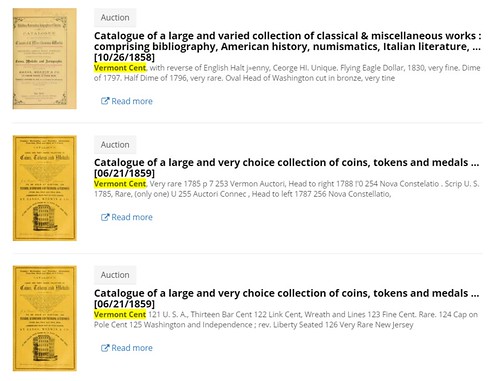
Left: Search Terms; Right: Sample Search Results
A new, advanced search function on the Newman Portal now allows users to more closely tune their search results. The search fields are self-explanatory but a couple examples are instructive. Suppose one wants to search for auction appearances of Vermont cents in auction catalogs between 1850 and 1860 – in this case select “Auction Catalogs” in the Content Type field, set the Publication Year from 1850 to 1860, and enter the text “Vermont Cent” (or “Vermont”) in the Search field. “Vermont Cent” yields 16 matches, primarily from Bangs and Cogan sales.
As another example, contributing organizations can now specifically search within their own content. Setting Title to “Penny-Wise” and the text to “S-15”, for example, yields over a hundred mentions in Early American Coppers’ Penny-Wise of this well-known 1793 large cent variety.
Link to NNP Advanced Search Form:
https://nnp.wustl.edu/Library/AdvancedSearchForm


NOTES FROM E-SYLUM READERS: MARCH 12, 2017
More on the Liberty Trust Company of Maryland Plaque
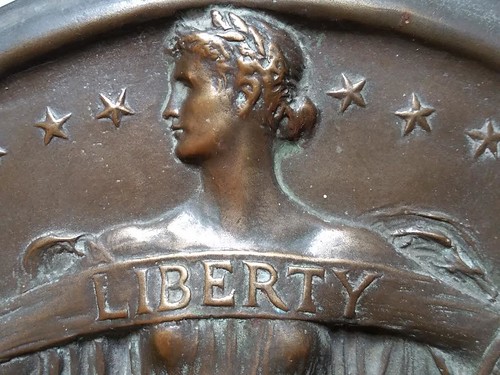
Regarding Alan Stullenbarger's plaque removed from the Liberty Trust Company of Maryland building, Paul Cunningham writes:
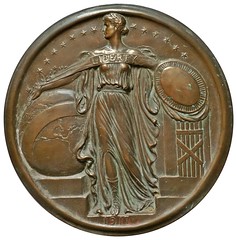 I was honored to be able to inspect and heft that lovely 12 inch, eight pound "kinda looks like a Liberty Standing Quarter, doesn't it!" plaque at the Tennessee State show
this past weekend. If one could date when that bank building was built and the plaque attached to same, one could perhaps narrow down when it was made. If the bank and plaque appeared in 1912, for
example, you have an argument for calling the plaque an SLQ pattern.
I was honored to be able to inspect and heft that lovely 12 inch, eight pound "kinda looks like a Liberty Standing Quarter, doesn't it!" plaque at the Tennessee State show
this past weekend. If one could date when that bank building was built and the plaque attached to same, one could perhaps narrow down when it was made. If the bank and plaque appeared in 1912, for
example, you have an argument for calling the plaque an SLQ pattern.
If the bank and plaque came into existence some years after 1916, then it is intuitively obvious that the bank decided to generally copy the beautiful Standing Liberty Quarter of the day!
To read the earlier E-Sylum article, see:
QUERY: WHO MADE THIS MARYLAND MYSTERY PLAQUE? (www.coinbooks.org/v20/esylum_v20n10a18.html)
E-Sylum Advertising
Fred Liberatore of Massachusetts writes:
Another in a long line of excellent E-Sylum publications. Glad to see the ads, especially from booksellers. They enhance the publication.
The Joseph Brothers in 1852
In the ongoing discussion between researchers Bob Leonard and John Lupia regarding California fractional gold sellers the Joseph Brothers, Bob Leonard writes:
Lupia is arguing that the Joseph Brothers were not even in business in San Francisco until September/October 1852. This ad appeared in the Sacramento Daily Union, January 19, 1852:
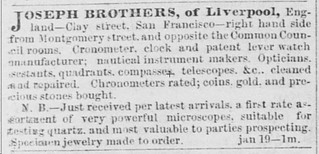
Note too that the Joseph Brothers were buyers of "coins" (this would be silver coins, not collector coins) and "gold" (i.e., gold dust).
As you can see, the Joseph Brothers were indeed in business on Clay street in San Francisco as early as January 19, 1852--and had clearly been in business there for some time, since they are advertising a new shipment. They later advertised that they were established in San Francisco in 1850, and one "J. Joseph" disembarked from the S.S. California November 21, 1850 (San Francisco Daily Alta California, Nov. 21, 1850), so this is likely.
The Joseph Brothers were well positioned to coin some of the native gold they bought into half dollars in 1852.
To read the earlier E-Sylum articles, see:
THE JOSEPH BROTHERS (www.coinbooks.org/v20/esylum_v20n02a16.html)
MORE ON THE JOSEPHS AND NUMISMATIC RESEARCH (www.coinbooks.org/v20/esylum_v20n04a11.html)
1948 VIEW OF CALIFORNIA FRACTIONAL GOLD (www.coinbooks.org/v20/esylum_v20n10a16.html)
More On Arabic Numerals and Dates
John Lupia writes:
Arabic numerals could not have been introduced in 787 simply because they did not yet exist. Possibly 200 or 250 years earlier Brahmi numbers also known as Hindu numbers originated that form the basis of what later on evolved into Arabic numerals. The connection between them dates to circa 825 when an Arab scholar known as Al-Khwarizim wrote about this Hindu mathematic system in a treatise translated as “On the Calculation with Hundu Numbers”. Shortly afterwards other Arabic texts continued this study and evolved the Arabic numeral from them making modifications in the glyphs used to represent quantities. This became assimilated in the West at the beginning of the 13th century through business and trade in the Mediterranean with Pisan and Venetian businessmen traveling along the Mediterranean rim on the African continent that was Arab populated. One of the sons of these Italians merchants was educated there travelling with his father known as Leonard Pisano Fibonacci, who was a mathematician and inventor of Fibonacci numbers.
As for any coin bearing the date A.D. 515 that is simply absurd. Dionysius Exiguus, a monk, circa 525/7 calculated the birth of Christ to A.U.C. 753 on the Roman calendar. Many credit the use of Exiguus’ calculations to the Venerable Bede, an English historian writing in the late 7th and early 8th centuries. Consequently, it is from the 8th century on we begin to find the Exiguus system used. This is where, in the West, we receive the date today since it was adopted in the Gregorian calendar in 1582.
To read the earlier E-Sylum article, see:
NOTES FROM E-SYLUM READERS: MARCH 5, 2017 : On Arabic Numeral Dates (www.coinbooks.org/v20/esylum_v20n10a11.html)
More On The Butler Colored Troops Medals
Bob Julian writes:
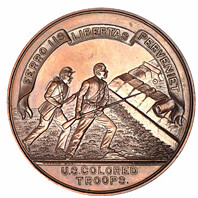 I saw the excerpt from the article (in the last E–Sylum) that I did on the Butler medal but there was a minor error. It was not in Numismatic News but rather Coins
Magazine for April 2017.
I saw the excerpt from the article (in the last E–Sylum) that I did on the Butler medal but there was a minor error. It was not in Numismatic News but rather Coins
Magazine for April 2017.
Tony Terranova writes:
The article states "the silver ones with few exceptions had the recipient's name engraved on the edge". The "named" ones were done by the recipients themselves, not "issued" in that form. Sometimes, the way the written word gets structured, the wrong information gets put forth.
To read the earlier E-Sylum article, see:
MORE ON THE BUTLER COLORED TROOPS MEDAL (www.coinbooks.org/v20/esylum_v20n10a19.html)
More On 'America's First Medals'
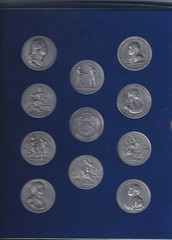 Bill Hyder writes:
Bill Hyder writes:
I missed your question about the "America's First Medals" set, but saw the responses. I still have my set that I assembled by ordering from the mint at the time. The set was originally advertised as having the Libertas medal in it, but the mint ran into reproduction rights conflict with the Paris mint. I suspect the holders had already been designed and produced, so the Treasury medal was needed to fill the hole.
I know it is not valuable, but it is still a neat set and has survived on my bookshelf all these years.
To read the earlier E-Sylum article, see:
MORE ON AMERICA’S FIRST MEDALS (www.coinbooks.org/v20/esylum_v20n10a10.html)
NCIS: Los Angeles Finds a 1933 Double Eagle
Sandy Pearl of Palm Beach Gardens, FL writes:
I was pleasantly surprised the other night watching NCIS: Los Angeles. The plot was about criminals trying to steal a 1933 Double Eagle. They actually got the information about the coin somewhat accurate even given artistic license. Their plot was about a Secret Service agent searching for one of the “other” 1933s than the one sold at auction – which they discussed to a general degree - over a decade ago in NY. They “found’ it by learning it was buried with a descendent of one of the people who bought it years ago. It wasn’t a great plot but the numismatic aspect kept me watching until the conclusion.
For more information, see:
NCIS: Los Angeles Old Tricks S8 Ep15 (42:55)
(http://www.cbs.com/shows/ncis_los_angeles/video/
i_j7tBpO4vy7MY46eH3U_5EoK3mJLeVf/ncis-los-angeles-old-tricks/)
The BEP Hydrostatic Press Room
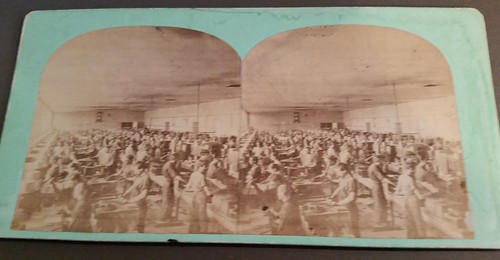
Joe Esposito writes:
I picked up this stereoview at an early photograph show in Arlington today. It’s showing the making of currency in the Hydrostatic Press Room at the Bureau of Engraving and Printing. An identical image, with a yellow rather than this blue-green border, is part of the New York Public Library’s digitized collection and is dated 1866. I thought readers might be interested in it.
Query: Who Are JHU and GDH?
Chester Sullivan writes:
Maybe readers can help me discover the identities of two numismatists who are identified only by initials. One appears in the William Anton ad in the Feb. '05 issue of The Numismatist. Item #20 of that ad offers the unique brass Castorland for the bargain price, in today's market, of a mere $245,00.00. The coin is said to be "Ex JHU." Persons better informed than myself might recognize JHU.
And in the 1867 vol. 2, No. 6, October issue of the American Journal of Numismatics there is an article titled "The Castorland 'Half Dollar' a Misnomer". The article is signed G. D. H.
Any help identifying JHU and GDH would be sincerely appreciated.
Help Wanted: Antarctic Post Office
 With no running water and sub-zero temperatures, it’s certainly a first-class challenge.
With no running water and sub-zero temperatures, it’s certainly a first-class challenge.
But that hasn’t stopped 265 people applying to run the world’s most southerly post office – at Port Lockroy, in the British Antarctic Territory.
The outpost, which has a colony of 2,000 penguins, is visited by 18,000 cruise-ship passengers between November and March. Staff, who hand-frank 80,000 letters, are warned they may have to go two weeks without a shower.
Dick adds:
Wait a minute. What do you mean, crazy? A free, all expense paid trip to Antarctica - where do I sign up?
But I do live in Alaska, where we had a couple spells of -30F this year (no where near the records), and more snow than in the last 20 years. When we built our house 40 years ago, we lived in the basement with no indoor plumbing and showered at the gym at the university (ok, every day, not every two weeks).
We live at the end of a 1/2 mile road with the driveway from hell (there are days I have to put chains on my 4-wheel drive F-250 pickup to get up the driveway), I haul water (400 gallons at a time) and empty it into a 1000 gallon underground tank (yes, I am surprised it does not freeze), and we burn coal to heat the main part of the house (an oil furnace is our backup, heating the basement). My wife wants to move into town, and I just cannot conceive of it.
So, does that qualify me as crazy?
To read the complete article, see:
How 265 people are in the race to run an Antarctic post office in an outpost - with only a
colony of 2,000 penguins as neighbors (www.dailymail.co.uk/news/article-4304978/265-people-race-run-Antarctic-post-office.html)
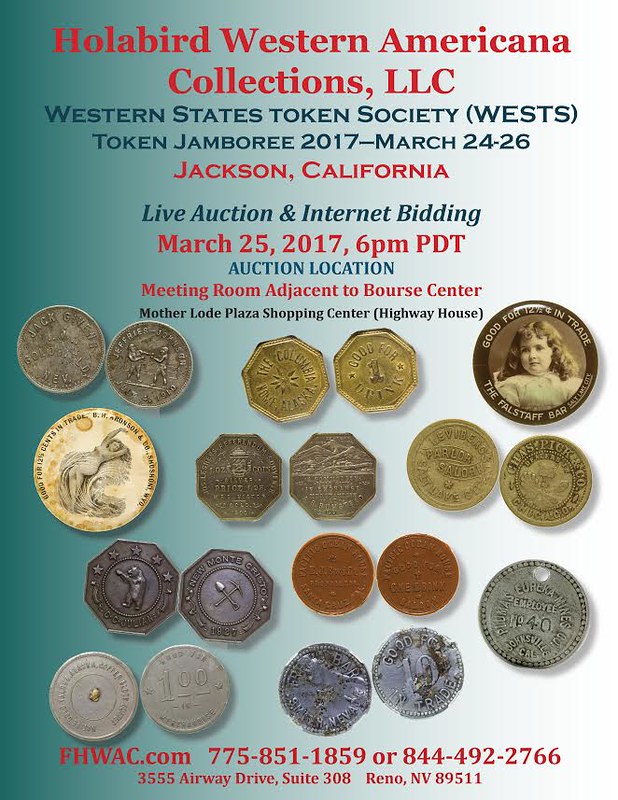
MORE ON THE THREAT OF COLLAPSING BOOKSHELVES
Last week I wrote (about my library), "Someday the whole thing may explode and bury me in a pile of biblio-debris." Ken Berger writes:
I think you meant your books will implode & collapse on you, not explode.
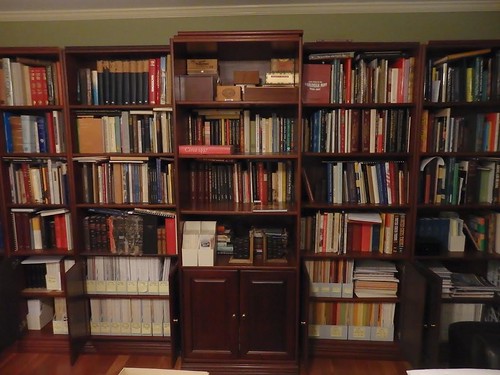
Ron Thompson's Library
Ron Thompson of Decatur, Georgia writes:
There should be a term for the fear of dying under your own bookcase and books. Perhaps your readers can come up with one. Here is my tale.
When I moved into my home in Georgia it came with a 12 foot wall bookcase. That was an attraction to me since I had lots of books to fill it. Several years later the bookcase was filled. The overflow went first to the top of the bookcase and then into some barrister bookcases in the halls – no double booking for me!. And then our condo association decided to do a number of construction projects to upgrade the facilities including repaving.
Construction makes lots of noise and also vibrations, which you sort of get used to eventually. After the construction projects were complete I noticed one day that many of my books had migrated on their own, like those famous moving stones in Death Valley, from the back of the shelves to the front and some actually were a bit over the edge of the shelf. I pushed on the bookcase and moved backwards then forwards again! I could just visualize the whole thing falling on me! I immediate pushed every book as far back on the shelf as I could. That realigned the center of gravity so the bookcase is much more stable now, but I periodically check to make sure all the books are pushed all the way back. I have also removed the books on the top of the bookcase to further lower the center of gravity.
Martin Purdy of New Zealand writes:
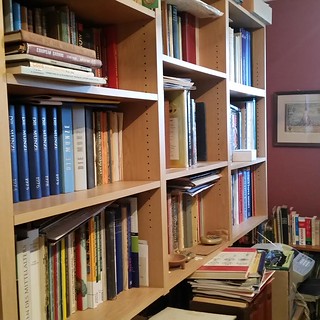 Boy, does this story make me feel better! When we enlarged our house, we set aside one "bedroom" as a library, and shelved both the long walls, thinking that would meet our needs
for the foreseeable future.
Boy, does this story make me feel better! When we enlarged our house, we set aside one "bedroom" as a library, and shelved both the long walls, thinking that would meet our needs
for the foreseeable future.
Fifteen years on, some shelves are double-stacked, I have longer books sideways on top of smaller books standing vertically, there are piles of books on the floor, and the shelving has expanded into the lounge, hallway and upstairs landing, not counting the shelves that are part of my separate office anyway.
I'm currently cataloguing just the coin and language-related books, and limiting myself to listing ten a day so I don't drive myself nuts or become so daunted by the prospect that nothing happens at all. I'm discovering some interesting titles that I'd entirely forgotten were in there, though I try to avoid at least some of the blame for that: at the time we were working on the house I acquired most of the numismatic library of a numismatist who'd been active in the 1960s and 70s, and a lot of his material was shelved quickly by size and not looked at too closely in the rush.
We're in earthquake-prone territory so I have some fears of what may happen with a decent shake, though there is some consolation in realising that the "library" looks rather like the "big one" has already happened!
To read the earlier E-Sylum article, see:
NOTES FROM E-SYLUM READERS: MARCH 5, 2017 : Library Organization, Or Lack Thereof (www.coinbooks.org/v20/esylum_v20n10a11.html)

JEFF BURKE'S NUMISMATIC DIARY MARCH 12, 2017
“My Numismatic Adventures with Dave Bailey and Friends”
Dave Bailey and Fran Cackowski are well known to the Garden State Numismatic Association (GSNA) members in New Jersey. Dave serves as President of the GSNA and Fran edited the New Jersey Numismatic Newsletter for twelve years. At present, Fran is the recording secretary of the GSNA. On May 15, 2016, I enjoyed visiting Dave and Fran’s cozy home on Staten Island.
Dave gave me the tour of his “man cave” where he does his numismatic research and writing. What a vast collection of books! He also showed me some examples from his Conder token collection including half pence and farthing pieces. Dave explained the intriguing history behind each piece. He started collecting Conder tokens in 1973. Fortunately, Dave stores his numismatic treasures in safe deposit boxes so he doesn’t have to worry about home safety issues. Fran showed me some of the beautiful quilts she has sewn.
Two months later, I joined Dave B. and Dave Noyes on a train from the Metro Park Station in Iselin, N.J. to the Baltimore Show. Both gentlemen are active members of the Watchung Hills Coin Club which has a vibrant YN program. Noyes, a former rugby player at Dartmouth and the University of Michigan, has foreign currency notes from over 200 countries and is eager to add new specimens to his collection. Noyes also collects classic commemoratives, fractional currency, national bank notes, New Hampshire scrip and obsoletes. He earned an M.B.A. from the University of Michigan in 1972 and has had a distinguished career as a banking, finance and insurance executive.
When Noyes was about six, he picked out 10 or 11 pieces from his dad’s coin collection to spend at a local candy store in Richfield Park, N.J. The young lad ended up buying sweets with an 1877 Indian Head cent and a 1909-S V.D.B. Lincoln cent, among other collector coins. Needless to say, Dave’s father had an informative talk with his son after the incident. Fortunately, the Noyes family was able to recover all but one of these misspent treasures!
Carl, Dave’s father worked as a bank teller in Haverhill, MA during the Depression. As a teller, Carl swapped out Indian Head cents and Lincoln cents from his own spare change. These coins formed the basis of his coin collection. Later, Carl was CEO of the First New Hampshire Bank, when he got to know Dave Bowers. Noyes collects New Hampshire National Bank notes in memory of his dad because these banks were part of his father’s holding company. Dave has expanded his collection from the eight or so banks in the holding company. Today, Dave Noyes is referred to as “Dave number three,” in reference to his friendship with New Hampshirites Dave Bowers and Dave Sundman.
The indefatigable Dave Bailey taught middle school math and history from 1967 until he retired in 2002. Since then, he has worked as a substitute teacher in Staten Island schools where he has served his entire career as a teacher. This year marks his 50th year as an educator! Dave collects ancients, Conder tokens and Civil War tokens, German, French and North American jetons, and medieval coins, and has many other numismatic interests as well. Bailey feels that holding a medieval or ancient coin in your hands transports you back in time. Dave recalls filling out Whitman blue albums of various denominations during his childhood.
Around 1965, Dave unearthed a William III half penny dated 1699 while digging near a church on Staten Island. This discovery piqued his ongoing interest in learning about all sorts of numismatic coins, tokens and medals. He also remembers finding a 4th century Emperor Valens Roman coin for a dollar in a dealer’s junk box as a college student, circa 1967. Dave had Latin in high school which helps him decipher words on ancient coins. Staten Island Coin Club member Tom Sarrow was skillful at helping him acquire ancient coins.
Conder Tokens
In the early 1970s, Dave saw an ad in the back of Coin World for Conder tokens. He acquired the dealer list of Conders and placed a phone call to order his first token. After purchasing the
Seaby book on Conder tokens, he began to order more Conders (merchant tokens in England) from the Colony Coin Shop in Newtonville, MA, run by Arthur Fitts and Neil B. Todd. Dave’s prize Conder token
(which I’ve had the pleasure of examining) is a Suffolk Cardinal Wolsey gateway piece, one of only four struck in 1795! This token, once owned by James Conder himself, has collector tag pedigrees
dating back to 1901 that now include Dave Bailey.
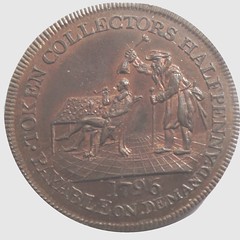
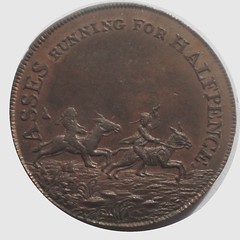
Collector's Halfpenny token
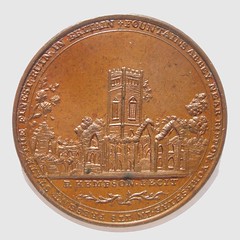
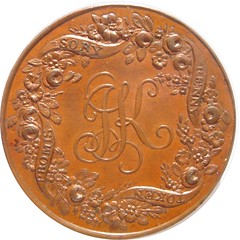
Peter Kempson token
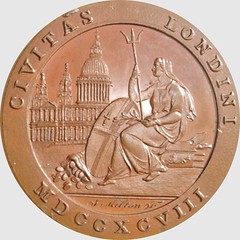
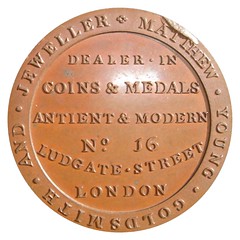
Matthew Young token
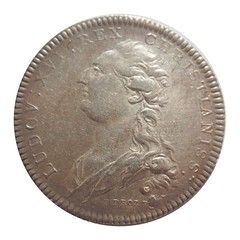
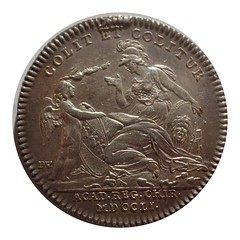
Louis XVI Jeton
Baltimore
After arriving in Baltimore we took a taxi to the convention center. It was exciting to enter the bourse! I accompanied Dave B. to look through the French jetons that Bill Goetz had at his table.
Dave helped me pick out a beautiful 1802 French Consulate Chamber of Commerce Rouen silver jeton. Next we stopped at Steve Damron’s table (Clein’s Rare Coins and Damron Numismatics) where Bailey
helped me select a 1795 Suffolk, Ipswitch, Beccles AE ½ Penny Conder token with reflective surfaces. Then I went with Dave to Donald and Marcella Zauche’s table where he examined a tray of Bronze
Roman coins.
At that point I decided to wander off on my own for a while before lunch. I stopped by Eagle Eye Rare Coins to say hello to Rick Snow and then headed over to Jim McGuigan’s table where I got to hold two high grade early half cents: a chocolate 1793 B-3, C-3 PCGS EF-40, and an olive brown 1793 B-3, C-3 PCGS AU-53. I was in numismatic heaven because a high grade 1793 half cent is my dream coin! Jim and I had a delightful talk about EAC and the upcoming EAC Convention in Philadelphia in April 2017.
I had a wonderful lunch with my travel companions at the Pratt Street Ale House a few blocks from the Convention Center. We discussed the news that the bourse would be closing early at 4 p.m. instead of the usual time of 6 p.m. because of a possible protest at or near the Convention Center. Some dealers had already packed up and headed home. We decided to stay at the show until 3:45 and then make our way back to the train station. As it turned out, Baltimore was quiet that night.
After lunch, I went over to Tom Reynolds’ table to look at his high grade 1793 and 1794 half cents and large cents. Then I walked around the bourse until it was time to depart. We caught the Purple Route (free) bus to head to the train station. En route on Charles Street, we passed the historic Hotel Monaco where Dave B. and Dave N. have stayed on their previous trips to Baltimore. Downtown Baltimore has such lovely, old buildings. We also passed the Washington Monument, which was quite a sight!
We found a table in the café at the Beaux-Arts style train station (worth a visit) constructed in 1911, and ordered cold refreshments on a hot day. Then we just relaxed and showed each other our bourse acquisitions. My Conder token and jeton were each purchased for under $100. It occurred to me that forging and enjoying numismatic friendships combined with making modest purchases can be just as fun as spending thousands of dollars on coins at a show. The fun is still in the hunt and acquisition!
American Numismatic Society
My next sojourn with Dave Bailey took place in Manhattan on July 22, 2016. Despite the scorching hot day, we met at 10 a.m. in front of the Gothic Revival style Trinity Church located at Broadway and
Wall Street, the oldest church in New York. We walked through the church and then spent some time looking at old tombstones in the graveyard. We found the marker for Alexander Hamilton, as well as
several other famous New Yorkers. After leaving Trinity Cemetery, we walked by Federal Hall where George Washington had his first inauguration as president in 1789.
Then, we meandered our way over to the American Numismatic Society (ANS) at 75 Varick Street, Floor 11. First, we looked at exhibits on Augustus B. Sage as well as Vladimir and Elvira Clain-Stefanelli; next we walked down to the library. ANS Librarian David Hill gave us a friendly welcome and took the time to retrieve several items for us from the Rare Book Room including an article on “James Conder; His Books and Tokens, with Some Remarks on His Contemporaries and Successors,” in Numisma, vol. 1, no. 7 (October 1948), pp. 113-130; and the book An Arrangement of Provincial Coins, Tokens, and Medalets, by James Conder, published in Ipswitch, England, in 1798. Dave felt transported back to 1798 while reading the latter reference!
After our respite in the cool and quiet ANS Library, we headed out to the Broom Street Bar (located in a landmarked building dating back to 1825) at 363 West Broadway to have lunch before heading to the subway station to go our separate ways. It was a fun day of activities in the Big Apple and we look forward to our next numismatic adventure, wherever it takes us!
THE BOOK BAZARRE
THE COINS PLACED ON LINCOLN'S EYES
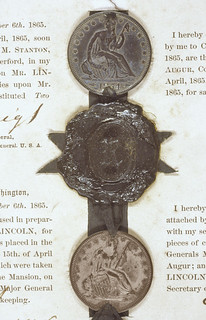 Regarding last week's item on C. F. Gunther, David Lange writes:
Regarding last week's item on C. F. Gunther, David Lange writes:
Among the many items in C. F. Gunther's Civil War collection were the two half dollars placed upon Abraham Lincoln's eyes at the time his death. These coins, dated 1854 and 1861, respectively, are still held by the Chicago Historical Society. I wrote about this episode for my column in The Numismatist three years ago, and it may be viewed also at NGC's website, too.
To read the complete tumblr article, see: two-silver-half-dollars-allegedly-placed-on (http://chicagohistorymuseum.tumblr.com
/post/116476172969/two-silver-half-dollars-allegedly-placed-on)
To read the complete NGC article, see:
USA Coin Album: Scrapbook Gold - Part 3
(www.ngccoin.com/news/article/4397/USA-Coin-Album-Scrapbook-Gold-Part-3/)
To read the earlier E-Sylum article, see:
CHARLES FREDERICK GüNTHER (1837–1920) (www.coinbooks.org/v20/esylum_v20n10a15.html)
VOCABULARY TERM: CLIPPED PLANCHET
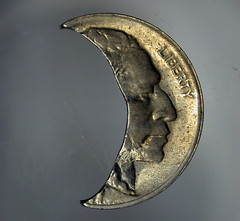
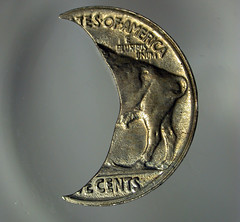
This is an extreme clipped planchet. The diagnostic for a genuine clipped planchet is the overhang around the inner edge of the piece. This is caused by metal flow over the edge at the rim/edge juncture during striking. Counterfeit clipping cannot reproduce this formation. Photos Fred Weinberg.
Clipped Planchet. An imperfectly punched blank or planchet in which the metal strip (from which blanks are punched) did not advance far enough under the blanking punch and "clipped" a portion of a previous hole. Clipped planchets range from only a small percentage of the total blank missing to crescent shaped pieces with 60% or more missing. In production blanking all blanks are fed into a riddling drum in which such malformed blanks drop out and full-circle blanks are passed on to the next process. These clipped and imperfectly formed planchets – called SCISSEL – are melted and reprocessed.
If the positioning of strip is near the edge or end of the strip this could cause a straight edge clip (less common). If the edge had not been machined straight this could cause a ragged edge clip. More dramatic perhaps are multiple clips that exist when this error of positioning occurs in two (double clipped), three or (rarely) four places. (More than four are impossible.)
An elliptical or oval clip is the name given to a struck piece on an oval (instead of circular) planchet. It occurs when the blank does not fall into the hopper but rests instead on the strip and is planked with the next planchet, it is not full round but is cut into two pieces – one oval and one crescent – either or both of which may end up being fed into the coining press.
When a clipped planchet is struck into a coin or medal, metal flows over the edge of the clip forming minute overhang at the RIM/EDGE JUNCTURE. Counterfeit clips – intended for
collectors – have been made by shearing off small circular portions after the item is struck, but this can be detected by the sharp angular corners without the overhang at the rim/edge juncture. See
BLANKING
CLASS 06.9

FRANK M. PINKERTON (1871-1930)
Frank M. Pinkerton (1871-1930), was born in November 1871 at Marshalltown, Iowa, the fifth of seven children, son of Asa Pinkerton (1834-1892), a farmer/gardener, and Anna E. Stewart Pinkerton (1840-1891). His family had lived in Illinois and moved to Marshalltown, Iowa soon before Frank M. Pinkerton was born. His family lived on their farm at 803 Jerome Avenue. He lived his whole life in Marshalltown and never married. After graduating the local school he worked in town as a clerk.
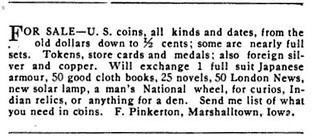 In the December 1904 issue of The Numismatist, page 378 he ran a six-line ad selling coins. In the January 1905 issue of The Numismatist, page 32 he ran the same six-line ad
selling coins.
In the December 1904 issue of The Numismatist, page 378 he ran a six-line ad selling coins. In the January 1905 issue of The Numismatist, page 32 he ran the same six-line ad
selling coins.
He also advertised as a coin dealer in Philatelic West, Vol. 31, No. 1, September (1905). According to Tom Elder Pinkerton was a winning bidder in his September 1905 auction, received his coins but never paid. He mentioned this in two issue of the Elder Monthly in 1906.
Thomas Lindsay Elder reported in his Elder Monthly, April (1906)
"F. M. Pinkerton, Marshalltown, Iowa. Received $43 in American gold coins which he secured at auction and failed to either pay for or return. The postal officials and collection bureau are after him hot-foot."
When there was a problem with the mail not only the buyer but the Post Office was to blame with Tom Elder. Judging from the facts presented by Elder it seems unfair to have condemned Pinkerton based on the evidence. It may have been a genuine case of mail tampering in which both parties, i.e., Elder and Pinkerton, were victimized. But, Tom Elder, hot-tempered and short-fused could only see his point of view, neither that of either Pinkerton nor the Post Office officials. When a deal went wrong "everybody was wrong and at fault" in Elder's mind. Although Elder is pugnacious you still can't help liking him and feeling bad for him about this particular case since he was robbed one way or the other.
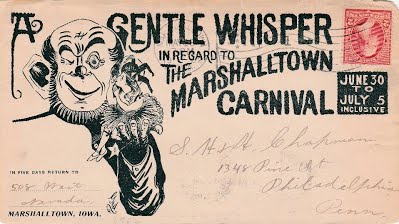
Correspondence of Frank M. Pinkerton to the Chapman Brothers, postmarked May 28, 1902. A very rare piece of circusiana
In early 1909, he [Pinkerton] opened his Art & Novelty Store, 508 West Nevada, Marshalltown, Iowa.
He died of pernicious anemia on March 30, 1930 at the Deaconess Hospital, Marshalltown, Iowa. He is buried in the Riverside Cemetery, Marshalltown, Iowa. His estate sold his real estate on May 31, 1930 for $10,000.
To read the complete article, see:
PINKERTON, FRANK M.
(https://sites.google.com/a/numismaticmall.com/www/numismaticmall-com/pinkerton-frank-m)
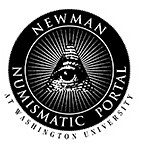
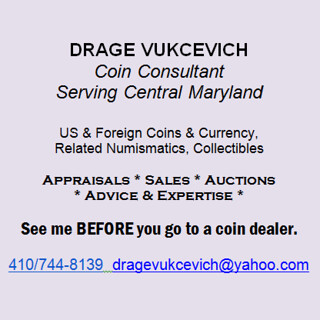
MAXIMILIAN SALMON (1857-1925)
Last week Pete Smith wrote:
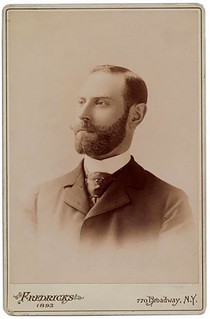 I have been working to fill gaps in American Numismatic Biographies for the listing on the Newman Numismatic Portal. One early numismatist has been known only by his first initial
and last name. This made him hard to identify. His address was known from an early publication.
I have been working to fill gaps in American Numismatic Biographies for the listing on the Newman Numismatic Portal. One early numismatist has been known only by his first initial
and last name. This made him hard to identify. His address was known from an early publication.
I found a city directory of a clerk with that last name living at that address. I learned that he moved to a new city and got involved selling stomach bitters. One of his bitters bottles would be a treasure to a bottle collector.
Can any E-Sylum reader identify this numismatist?
Can any E-Sylum reader identify another numismatist that crosses into the field of bottle collecting?
Denis Loring writes:
Robinson S. Brown, Jr. legendary large cent collector, had a terrific bottle collection (which he kept on display in his Kentucky house) as well.
Sometimes people with connections to numismatics also have connections to other hobby fields. Such is true of Maximilian Salmon. Much of this information can be found on a site related to bottle collecting:
Maximilian Salmon was born in Toronto, Canada, on March 31, 1857, of Prussian and Austrian ancestry. In the 1861 Census of Canada, he was listed as living in Arthabaska, Quebec, Canada. He moved to Baltimore at age thirteen. For the 1880 United States Census, he was listed as a store clerk living in Baltimore City, Maryland. He may have worked at his father’s liquor store.
By 1888 he moved to Manhattan. There he married Sophie Stern in 1890. They would have four children. In the 1900 U. S. Census he was listed as a wine merchant living in Manhattan. By 1907 he was affiliated with the Salmon Billers Company. Their bottles are treasured among collectors.
For the 1915 New York State Census he was listed as an insurance agent with the New York Life Insurance Company.
He died on November 6, 1925, and was buried from Temple Reni-El in Manhattan. He was active with the Masons and identified as a Past Master of Guardian Lodge, No. 921, F. & A. M.
The bottle article does not mention his involvement with numismatics. He conducted two auction sales in 1883 under the name of “M. Salmon” and that is the only way he has been known in numismatic literature. It was the discovery of a Baltimore city directory that provided his first name at 137 Pennsylvania Avenue in Baltimore. It is the same address listed for his father and for his father’s liquor store. It is an address I can’t find on a current street map.
No evidence has been found that he was a dealer in coins or even had a personal collection. His impact on the hobby was apparently minimal.
I asked about others involved with numismatics who cross into the field of bottle collecting. I was thinking of A. M. Smith whose bottles fill three shelves in my bookcase. Filed away somewhere is a bottle related to Robby Brown who was in the distillery business.
I attended a presentation given by Fred Holabird who talked about saloons that issued both tokens and bottles. I suspect there is more crossover between the two hobbies.
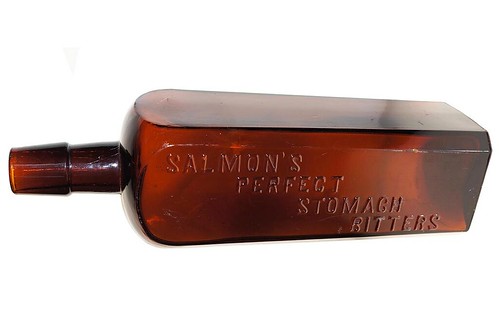
Thanks, everyone.
Speaking of Robbie Brown, I met him briefly at an Early American Coppers convention once. Nice guy. And I remember thinking, "But they're ALL nice guys. How come this one can afford to buy coins at $50,000 a pop?" The answer turned out to be the distillery business - his family founded the firm Brown-Forman in the late 1800s, and it owns a large stable of brands including Jack Daniels whiskey and Finlandia vodka. So I bought some stock in the company myself, in my retirement portfolio. I've made thousands of dollars on the stock since then. When I'm in my rocking chair on the front porch of the Old Numismatists Home, I'll have a few more dollars in my pocket thanks to Robbie Brown (but sadly, no five-figure coins). -Editor
To read the earlier E-Sylum article, see:
NOTES FROM E-SYLUM READERS: MARCH 5, 2017 : Quick Quiz: Who Is This Mystery American Numismatist?
(www.coinbooks.org/v20/esylum_v20n10a11.html)
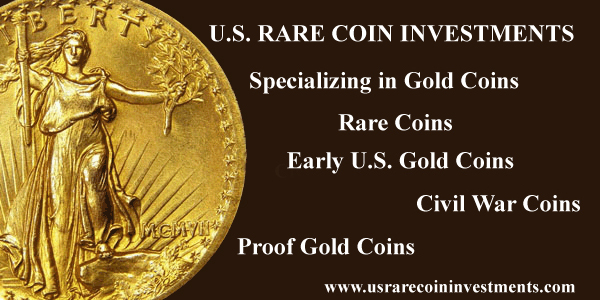
DWIGHT MANLEY MOVIE POSTER EXHIBIT
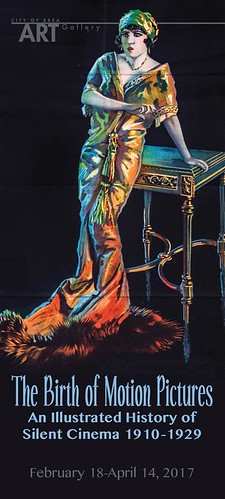 Prominent coin collector, dealer and philanthropist Dwight Manley, for whom the American Numismatic Association’s library is named, has another collecting passion: silent movie-era posters.
He has assembled the world’s largest collection of over 2,000 original posters and now is sharing a portion of it with the public through a museum exhibition in his hometown of Brea, California.
Prominent coin collector, dealer and philanthropist Dwight Manley, for whom the American Numismatic Association’s library is named, has another collecting passion: silent movie-era posters.
He has assembled the world’s largest collection of over 2,000 original posters and now is sharing a portion of it with the public through a museum exhibition in his hometown of Brea, California.
Manley led the successful 1999 acquisition and marketing of California gold Rush-era sunken treasure coins and ingots recovered from the fabled “Ship of Gold,” the SS Central America.
“Because of coin collecting I have a real appreciation of history, and I learned that most silent movie posters were destroyed as they were not meant to be saved. I began buying them. The largest cache known was in the range of 200 different posters, and I bought them all. The next largest cache was about 110, and I also bought them all. I scoured auctions, eBay, and price lists of silent film posters, and bought everything I could find. Today, I have approximately 2,000 posters,” Manley said.
More than half of the historic posters in the exhibition, “The Birth of Motion Pictures: An Illustrated History of Silent Cinema, 1910 – 1929,” are the only known surviving examples from those silent films and are being publicly shown for the first time in a century, according to Christina Mercer, Director of the City of Brea Art Gallery (www.BreaGallery.com).
The unprecedented, multi-million- dollar exhibition of 60 original silent movie posters and vintage early cinema memorabilia, including one of only 15 rare “Silent Oscars” awarded to a silent film, continues through Friday, April 14, 2017, at 1 Civic Center Circle in Brea.
Manley became interested in film posters eight years ago, after visiting actor Leonardo DiCaprio’s Hollywood Hills home. “He had some of the greatest horror film posters of all time, such as Frankenstein and Dracula. I commented how very cool they were. A few years later I needed some art to put on the wall of a new house in Brea, and came across an auction with a couple of neat posters,” Manley recalled.
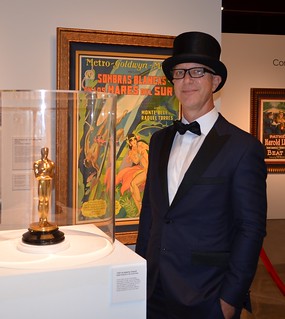 The rare “Silent Oscar” was for Distinguished Achievement in Cinematography, and presented to Clyde De Vinna (1890 – 1953) for the 1928 MGM film, White Shadows in the South Seas.
The rare “Silent Oscar” was for Distinguished Achievement in Cinematography, and presented to Clyde De Vinna (1890 – 1953) for the 1928 MGM film, White Shadows in the South Seas.
Among other highlights in the exhibition from Manley’s collection are posters from the estate of actor and director Lord Richard Attenborough (1923 – 2014) for the 1918 Charlie Chaplin film, A Dog’s Life, and the 1921 Chaplin and Jackie Coogan film, The Kid.
Another version of a poster for The Kid was from actor Jack Larson (1928 – 2015) who played Jimmy Olsen in the 1950s Adventures of Superman TV show and who received the poster as a gift from Chaplin.
The 1927 poster from the so-called holy grail of lost silent films, London After Midnight starring “the man of a thousand faces,” Lon Chaney (1883 – 1930), was acquired by Manley from Metallica guitar player Kirk Hammett.
The exhibition is open Wednesday through Sundays, Noon to 5 pm, and is hosted by the City of Brea as part of the Orange County California community’s 100th anniversary celebration. The exhibit will be made available in the future to other museums to continue sharing it with and educating the public.
For more information, see:
www.breagallery.com
That's Dwight in the top hat next to the Oscar statue. Numismatic bibliophiles, take note: "I learned that most ... were destroyed as they were not meant to be saved. I began buying them." That's the very definition of ephemera, and numismatic ephemera is equally endangered. People throw it way, and as a result even ordinary items become rare, and important items become quite valuable. I was lucky to learn this fact early on in my collecting career, and I've accumulated a nice collection of numismatic ephemera, such as posters, postcards, letters, flyers, booklets, pamphlets and the like. Be on the lookout for such material for your collection.
On a related note, here's a Washington Post obituary from the movie world. Serious collectors and scholars know one when they see one. In the world of movies, Turner Classic Movies host Robert Osborne was an original - a full blown movie fan and researcher. -Editor
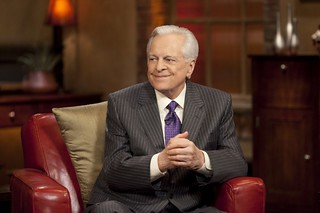 Robert Osborne, the urbane, silver-haired film historian who had been the principal host of the Turner Classic Movies cable channel since its founding in 1994 and was a genial ambassador
for an otherwise vanished era in filmmaking, died March 6 at his home in New York. He was 84.
Robert Osborne, the urbane, silver-haired film historian who had been the principal host of the Turner Classic Movies cable channel since its founding in 1994 and was a genial ambassador
for an otherwise vanished era in filmmaking, died March 6 at his home in New York. He was 84.
Besides its magnificent film trove, TCM owed a sizable portion of its growth as a brand to Mr. Osborne, an unalloyed cinephile and former acting protege of Lucille Ball’s who once was actress Bette Davis’s date to the Academy Awards.
Mr. Osborne was endowed with a talent for befriending stars, many of them marquee movie names of his youth. They were relegated to the shadows by the time he got to know them in the 1960s, forgotten by an industry that had unsentimentally moved on. “Somebody like Dorothy Lamour,” he told the New York Times, “she adored me. I knew she had sold more war bonds during the Second World War than almost anybody in Hollywood.”
He was bewitched not just by movies, but also by the boldly illustrated movie posters and fan magazines that featured impossibly alluring actresses such as Lana Turner and sloe-eyed Ann Sheridan. His fascination with movie promotion led him to study advertising and then journalism at the University of Washington.
To read the complete article, see:
Robert
Osborne, Turner Classic Movies host and film historian, dies at 84
(www.washingtonpost.com/entertainment/robert-osborne-turner-classic-movies-host-and-film-historian-dies-at-84/2017/03/06/a501c406-02a3-11e7-b9fa-ed727b644a0b_story.html)

VIDEO: U.S. MINT SCULPTOR JOSEPH MENNA
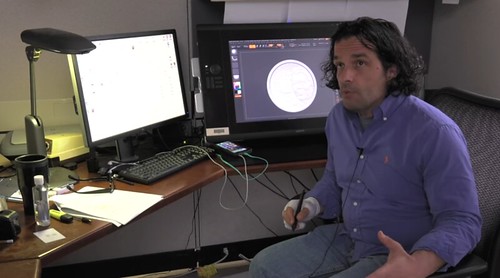
Joseph Menna is a a medallic sculptor at the United States Mint. If you've spent a Lincoln cent struck since 2010, you have spent a coin that Menna has sculpted.
Beyond the reverse of the Shield cent, he has designed or engraved dozens of coins and medals for the U.S. Mint, including the George Washington and Thomas Jefferson Presidential dollar obverses and the Martha Washington First Spouse gold coin obverse.
In this CoinWeek video, we go to the Mint's engraving department studio to talk to Menna about modern coin design, the role Proof coinage plays in design fundamentals, and which of his designs over the years truly stands out as his favorite.
To read the complete article, see:
CoinWeek IQ: U.S. Mint Medallic Sculptor Joseph Menna Talks Modern
Coin Design – 4K Video (www.coinweek.com/video-news/coinweek-iq-u-s-mint-medallic-sculptor-joseph-menna-talks-modern-coin-design-4k-video/)
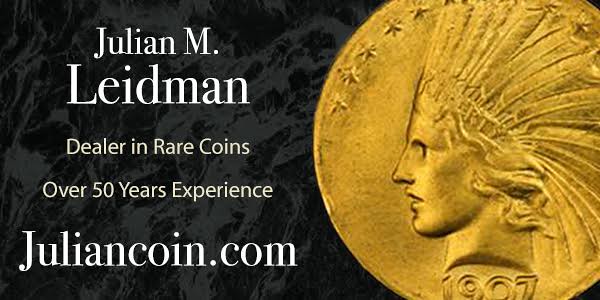
FAKE CALIFORNIA FRACTIONAL GOLD COINS
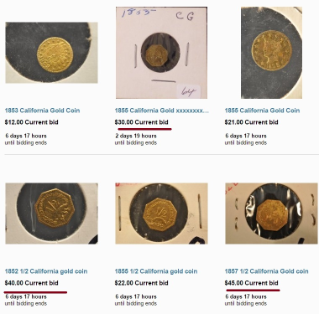
These tokens, usually brass or gold-plated, are routinely described in online auctions by the year, state, denomination and coin, as in the lot in the lower left of the photo above: “1852 ½ California gold coin.”
Every single word of that description is wrong. The token was not manufactured in 1852. It is not a half dollar. It does not come from California but, most likely, from Asia or a U.S. tourist shop. It is not gold. It is not a “coin,” a word that suggests it was minted by the government for commerce.
The reverse of an authentic California fractional gold coin has a denomination on it, such as 1/4, 1/2 and 1 DOLLAR. The word “dollar” is sometimes abbreviated as D. or DOL.
Brass or plated replicas usually have an odd-looking bear on the reverse, just like the one with a current bid of $40 in the lower left of the photo. I suspect that lot will go for $50 to $100 by the time of the auction.
I can buy the same ones at my local coin shop for $1 each.
To learn more about small and token gold, visit Mike Locke’s California Gold website or read my “Home Hobbyist” Coin World column about it.
In the meantime, my hope is that online auction portals do more than merely notify sellers about possible fake or misrepresented coins. Perhaps the best way to get the point across is to email the auctioneer, state your case and then do not bid anymore in his or her sessions.
To read the complete article, see:
FAKE CALIFORNIA GOLD STILL FLOODS ONLINE AUCTIONS
(www.coinworld.com/voices/michael-bugeja/2017/03/fake_california_gold.html)
THE BOOK BAZARRE
SELECTIONS FROM THE MARCH 2017 KAGIN'S SALE
Lot 1018: 1783 Treaty of Paris Medal
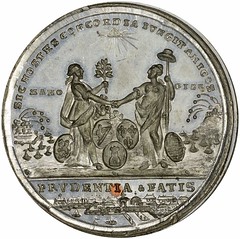
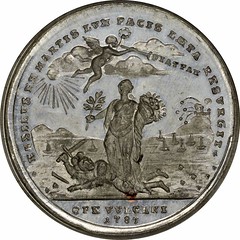
This medal was struck to commemorate the 1783 Treaty of Paris. The treaty formally ended the American Revolutionary War between the United Kingdom of Great Britain and the United States of America that had rebelled against their rule starting in 1775. The obverse depicts Peace with an olive branch greeting America who holds a pole with Liberty cap; at their feet are shields of Great Britain, France, Spain and the Netherlands. In the exergue is the legend PRUDENTIA-FATIS (By Prudence and the Fates). On the reverse Peace tramples on War lying prostrate with a broken sword in his right hand.
To read the complete lot description, see:
1018: 1783 Treaty of Paris Medal (http://auctions.kagins.com/1783-Treaty-of-Paris-Medal-MS65-NGC_i26659662)
Lot 1025: John T. Waterhouse Hawaii Token
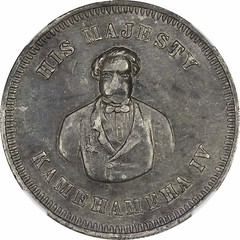
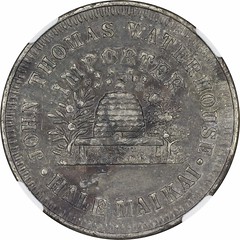
Hawaii Token. Undated (1855-1860) John T. Waterhouse. 2TE-1. Lead. Reeded Edge. AU-50 NGC.
Deep steel gray throughout with marginally lighter high points. Obverse: facing bust of king, HIS MAJESTY arcs above, KAMEHAMEHA curves below. Reverse: industrious bee hive at center, rose bush to viewer’s left, fruit tree to right, JOHN THOMAS WATERHOUSE arcs around, HALF MAIKAI curves below. Some light marks are present as befits such a soft composition. A rare prize from the expanding field of Hawaiian token collecting.
To read the complete lot description, see:
Hawaii Token. Undated (1855-1860) John T. Waterhouse. 2TE-1. Lead.
Reeded Edge (http://auctions.kagins.com/Hawaii-Token-Undated-1855-1860-John-T-Waterhouse-2TE-1-Lead-Reeded-Edge-AU-50-NGC_i26659894)
Lot 1625: C. Bechtler $5 Gold
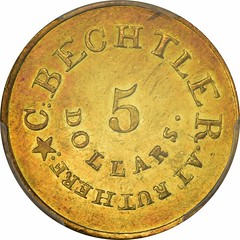
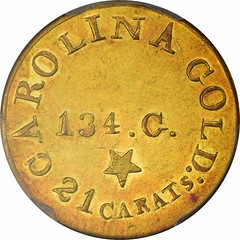
Undated (1834). C. Bechtler $5 Gold. Kagin-20. Rarity-5. With 134 G., Star. Plain Edge. Prooflike. MS-61 PCGS. Brightly reflective yellow gold surfaces and frosty patches of warm sunset orange offer up a visual treat for an attentive specialist. Other than some hairlines, you won’t find any serious blemishes hiding here. Though not called “prooflike” by PCGS, it is undeniably that in our estimation, including some rather deep mirror surface at the obverse rim. As elsewhere in the Bechtler series, the Rarity-5 rating given to Kagin-20 is misleading; it refers to the numerous circulated examples of the variety that buoy the reported population. In Mint State, Kagin-20 is a dynamic rarity in its own right. Indeed, the present specimen is tied for finest seen by PCGS, and in our opinion it is the second-finest example of the variety extant. This important Allan Collection Bechtler $5 should bring out the best among the many competitive specialists who will no doubt have this coin high on their want list-wish list. Our only advice is to be prepared at bidding time!
Obverse: CAROLINA GOLD: at rim from 8 to 4 o’clock around, 134.G. at center, inverted five-pointed star beneath, 21 CARATS curves at rim beneath star.
Reverse: C: BECHTLER: AT RUTHERF: and star around, 5 at center, DOLLARS. curves below.
Die Alignment: about 250 degrees.
PCGS Population: 2; none finer.
NGC Census: 1; MS-62
To read the complete lot description, see:
Undated (1834). C. Bechtler $5 Gold. Kagin-20. Rarity-5. With
134 G., Star. Plain Edge. (http://auctions.kagins.com/Undated-1834-C-Bechtler-5-Gold-Kagin-20-Rarity-5-With-134-G-Star-Plain-Edge-Prooflike-M_i26659781)
Lot 1675: $10 Die Trial on Classic Head Cent
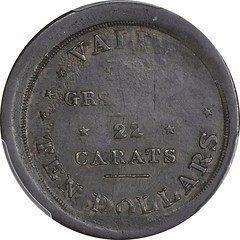
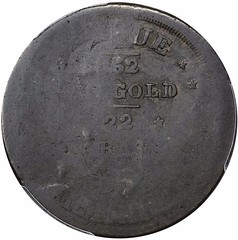
Undated (circa 1849) $10 Die Trial on Classic Head Cent 1810-1814. VF-30 PCGS.
K-1 (p.357 of Private Gold Coins and Patterns of the United States) 153.2gr; 30mm. 270 degree turned) Deep chocolate brown throughout. Many of the host coin’s details show including 1814 date. Unevenly struck on both sides from by the same die but more forcibly on the cent obverse than the reverse. Stylistically of the same non-descript tenor generally attributed to the early Gold Rush era, but without manufacturer’s identification. Weakly struck in areas. Obverse: VALU(E) arcs above, TEN DOLLARS curves below, 3 stars to left, 1 (of 3) to right, 2?? / GRS. ??? / 22 with star to each side / CARATS at center on four lines. Reverse: another impression of the obverse reading (VAL)UE at top, 262 / (G)RS GOLD / 22 with star to each side / CARATS – between the two impressions the entirety becomes clear.
The coin is generally similar in appearance and design to the Bechtler coinage and to a pattern also struck on an 1841 Large cent by Bechtler friend and executor, Heinrich Schaeffer (see pages 83 and 357 of Don Kagin’s book, Private Gold Coins and Patterns of the United States). However the punches are not an exact match. It is quite possible that either Schaeffer or another coiner experimented with striking coins during our nation's second gold rush in California.
We are not certain at all of the origins of this piece but can posit some reasonable speculation. This specimen first came to our notice as part of the noted Western historian and pioneer gold specialist, Henry Clifford’s collection. According to his records, Clifford acquired it 9/12/1957 from numismatic curator, Dr. T.V. Buttrey of Yale University. When Clifford’s non-gold pioneer coinage collection was sold by Bowers & Ruddy Galleries (3/82:118), it was purchased by numismatist John J. Ford. Stacks later sold this piece in one of the celebrated Ford sales (9/13:10103) where it brought $17,625 after fierce bidding.
Extremely Rare, intriguing, and unusual, and a numismatic item that has the power to enthrall territorial gold specialists, Bechtler gold and large cent enthusiasts alike.
Dr. T.V. Buttrey writes:
This is untrue. I have never had anything to do with this piece. I did not know Clifford and never did any business with him -- nor with anyone else for that matter.
To read the complete lot description, see:
Undated (circa 1849) $10 Die Trial on Classic Head Cent 1810-1814. VF-30
PCGS. (http://auctions.kagins.com/Undated-circa-1849-10-Die-Trial-on-Classic-Head-Cent-1810-1814-VF-30-PCGS_i26659956)
Lot 1684: 1860 Clark, Gruber & Co. Gold $2.50.
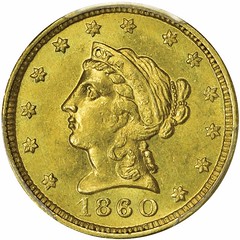
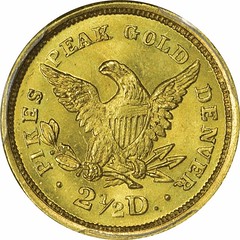
To read the complete lot description, see:
1860 Clark, Gruber & Co. Gold $2.50. Kagin-1. Rarity-4. MS-65 PCGS.
(http://auctions.kagins.com/1860-Clark-Gruber-Co-Gold-2-50-Kagin-1-Rarity-4-MS-65-PCGS_i26660023)
Lot 1720: 1853 Round Half Dollar, Arms of California
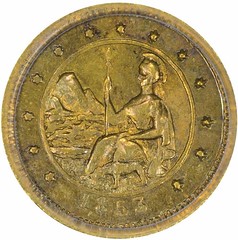
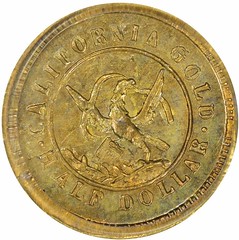
1853 Round Half Dollar, BG-435, Arms of California. MS63 PCGS.
Arms of California, 13 tiny stars around, date below; eagle with shield, CALIFORNIA GOLD/ HALF DOLLAR around. Unique designs make this a key to any type set of small California gold. Maker unknown (“Unknown Maker A”). In the second edition of California Pioneer Fractional Gold this cataloger speculated that BG-435 might be the work of San Francisco manufacturing jewelers Braverman & Levy, who did business under this style from 1852 through 1881. George Ferdinand Albrecht Küner, engraver of the Great Seal of California (and also the dies for many of the larger private gold coins of California), worked in Braverman & Levy’s store from the spring of 1852 until the spring of 1854. While the dies for BG-435 are not his work, an impression of the seal he engraved may have been displayed in their show window and perhaps featured on their sign in 1853—a visual indication of the issuer.
Merely Rare, but brings far in excess of most rarer issues because of demand from type set collectors. Lovely blue circular (“album” type) toning on obverse highlights the California arms, faint bluish cast with gold highlights covers reverse
To read the complete lot description, see:
1853 Round Half Dollar, BG-435, Arms of California. MS63 PCGS.
(http://auctions.kagins.com/1853-Round-Half-Dollar-BG-435-Arms-of-California-MS63-PCGS_i26659900)
Lot 1721: 1854 Round Half Dol., BG-436. Die State II
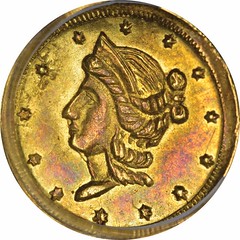
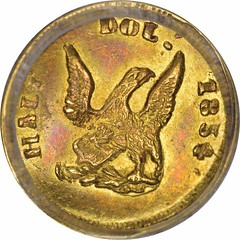
Bob writes:
My favorite is lot 1721, an 1854 round half dollar with eagle reverse, BG-436. BG-435 gets all the attention because of its unique design (Arms of California), but its late appearance has always troubled me (unknown prior to 1877). While BG-436 is not presently attested until 1883, it is more in line with the others of this period.
This odd piece (the eagle lacks a scroll) was probably made by Auguste Dubois (at least four variant spellings), in a secret room in the cellar of a house with all the windows blacked out except one, at the southeast corner of Green and Fayette streets in San Francisco. Mr. Dubois had a partner who was either named Waschwald or Oswald (sic!! both names given in contemporary accounts). When visited by the police, Dubois explained that he was not a counterfeiter as they supposed, but a maker of gold pens. But since he appeared to have the equipment necessary to strike gold half dollars, my supposition was that he tried his hand in 1854, but with little success.
This exact coin was in the outstanding collection of Jack Totheroh, co-author of the second edition of Breen-Gillio, California Pioneer Fractional Gold. I had the pleasure of cataloging it for Don Kagin in 2013.
1854 Round Half Dol., BG-436. Die State II ("period" die defect after date, "exclamation point" defect above period after DOL.) MS61 PCGS.
Unusual Liberty head with coarse curls and hollow neck, 13 stars around; eagle with shield and branch, but no scroll (!), HALF DOL. around 1854 . A somewhat amateurish effort by an unknown maker (“Unknown Maker B”). Perhaps the work of Auguste Dubois, as surmised by the cataloger in the second edition of California Pioneer Fractional Gold. (His name is spelled “Auguste Duboice” in the San Francisco Herald; “Augustine Dubois” in the Sacramento Daily Union; “Augustin Dubois” in the Placer Times & Transcript (the latter two citations courtesy of indefatigable Gold Rush researcher Dan Owens); and “A. Duboce” in LeCount & Strong’s San Francisco City Directory for the year 1854.
Mr. Dubois, who had a partner named John Waschwald or Oswald, operated out of a house on the southeast corner of Green and Fayette Streets with all the windows blacked out except one. The pair were accused of counterfeiting, and when this house was searched by the San Francisco police, a secret room was discovered in the cellar that held a rolling machine, furnace, crucibles, and a large amount of melted gold. When they returned to it, Auguste and John were arrested, but made bail and the charges were dismissed as false three days later. Mr. Dubois stated to the police that he had been a gold pen maker in New York, where he was from, and that his equipment was used for that purpose.
While that may have been his intention in coming to California, upon seeing small California gold in circulation he was probably tempted to join the party, since he had all the necessary equipment (except a screw press, and he probably had that also but omitted in the newspaper accounts). In any case, there seems to be no other suitable candidate for a maker for the year 1854 only.
To read the complete lot description, see:
1854 Round Half Dol., BG-436. Die State II
("period" die defect after date, "exclamation point" defe
(http://auctions.kagins.com/1854-Round-Half-Dol-BG-436-Die-State-II-period-die-defect-after-date-exclamation-point-defe_i26659901)
Lot 1810: 1946 United Nations Monetary Patterns
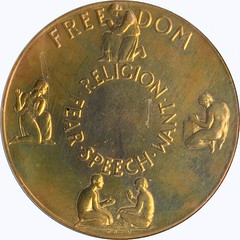
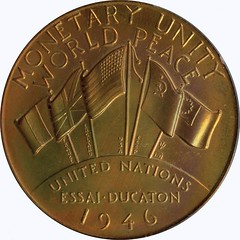
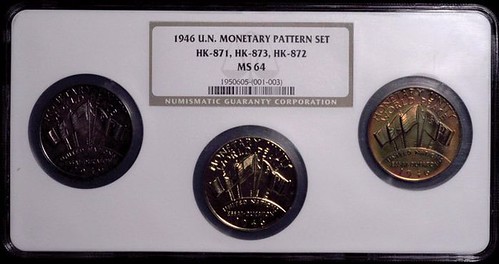
A 3 piece Set of 1946 United Nations Monetary Patterns, made in Gold, Silver and Bronze. HK-871,HK-873,HK-872. MS-64 NGC.
Conceived by numismatists Abe Kosoff and Hans Schulman as a UN based, universal currency several decades before the Euro. The design was a 1-ducat (U.S. dollar) sized coin, only to be used as the initial pattern to spark interest in the idea. In 1946 the Medallic Art Company of New York, struck only 313 specimens in 23.95 karat Gold, and 1,000 each in Silver and Bronze. When the UN failed to adopt the plan, the dies were quickly destroyed.
The obverse of the coin portrays flags representing the five nations appointed to the UN Security Counsel at the time. The design of the reverse is that of US President Franklin Roosevelt’s emblematic vision of the Four Provincial Freedoms: Freedom of Religion, Freedom from Want, Freedom of Speech and Freedom from Fear.
A majority of the gold specimens were melted during the peaking gold market in the 1980s leaving only a couple of dozen or so available.
Ex: Abe Kosoff.
To read the complete lot description, see:
A 3 piece Set of 1946 United Nations Monetary
Patterns, made in Gold, Silver and Bronze. HK-871,HK-8 (http://auctions.kagins.com/A-3-piece-Set-of-1946-United-Nations-Monetary-Patterns-made-in-Gold-Silver-and-Bronze-HK-871-HK-8_i26659873)
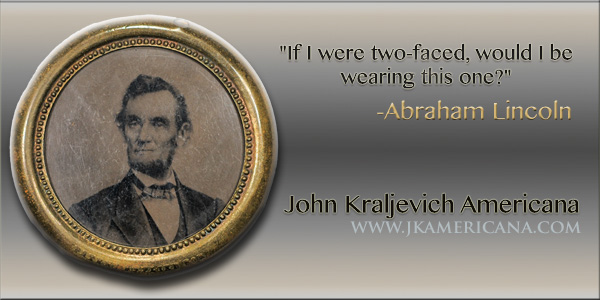
HOLABIRD MARCH 25 WESTS TOKEN SALE
March 25 WESTS Token Sale
Held by Holabird Americana (FHWAC) at the WESTS token show at 6pm after the bourse closes.
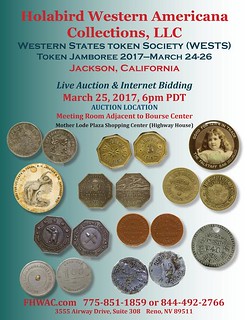 The 2017 March WESTS Token Auction features 261 lots from 25 states. The tokens represent some of the most popular and rarest of categories for each state, including a rare antler token,
pictorial tokens, Fort tokens, saloon tokens, rare western towns, CCC camps, encased cents, three sticker dollars and a few Hibler-Kappan So-Called Dollars.
The 2017 March WESTS Token Auction features 261 lots from 25 states. The tokens represent some of the most popular and rarest of categories for each state, including a rare antler token,
pictorial tokens, Fort tokens, saloon tokens, rare western towns, CCC camps, encased cents, three sticker dollars and a few Hibler-Kappan So-Called Dollars.
The states represented are, with number of lots in parentheses, Alaska (6) including a gold nugget token and saloon; Arizona (13) territorial and saloon pieces; California (58) including Forts, saloons, rare towns, Gold Rush, pictorial tokens; Colorado (29) including rare towns and pictorial; Hawaii (3) including Fort and saloon; Idaho (5) includes a GF mirror; Indian Territory (5) includes pictorial; Maryland, Michigan, Minnesota, Mississippi all (1) each; Montana (20) includes rare towns; Nebraska (1); Nevada (34) includes rare towns and pictorial; New Mexico (9) includes pictorial and encased; New York and Ohio (1) each; Oregon (17) Mirror, pictorial, saloons; Texas (1 saloon); Tennessee (91); Utah (9) including pictorial and saloon; Washington (18) Mirrors, pictorial, encased, Fort; Wisconsin (2 mirrors); Wyoming (915) includes mirror, saloon, antler token, Fort; Yukon (2), pictorial, encased.
Catalogs are available on line at FHWAC.com (click on the auction button), or through ICollector; printed catalogs are available BY REQUEST. Please call 775 851-1859 or email info@fhwac.com for the printed catalog. Bidding can take place in most any usual accepted form – advance bids by email, bids by FAX, bids by mail received by auction time (if you’re not sure -call!), bids by phone, bids online in advance through ICollector, bids live at the live auction, or through your friendly agent. Toll free 844-492- 2766 before the auction only.
For late Bidding during the sale, or to reach us when we are in Jackson, call one of two cell phones 775 247-4350 or 775 843-0229.
Fred adds:
This is intended to be a nice small, intimate sale. WESTS is one very friendly group of collectors. The show is lots of fun, usually with some exceptional material coming out of the woodwork.
If you like tokens and medals, and are within striking distance of Jackson, California near the foot of the famous Mother Lode, just a couple hours from Yosemite, you should try to come. There are many places to see in the region, including the original gold discovery site at Coloma, the quaint mining camps of Murphy’s, Angel’s Camp (Mark Twain and his Jumping Frogs), Sonora, and of course the fabulous wines of the Foothill Belt – you won’t want to miss it!

NUMISMATIC NUGGETS: MARCH 12, 2017
Ancient Greece - Mysia - Parium - Hemidrachme
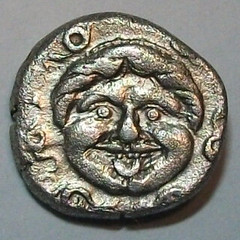
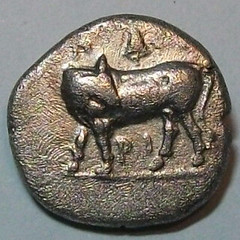
Diameter: 13 mm Weight: 2.25 g. Metal: silver. Specimen on an irregular oval flan, well-centred on both sides. Old collection patina with golden reflections.
Obverse: Bull standing on the left on a highlighted line, turning its head to the right. PA/RI. Reverse: Gorgon full face head, stylised hair, open mouth with tongue hanging out.
Type: rare R1.
Cf: SNG von Aulock 1319; BMC.14 ; SNG.Cop.257v.
Archaic style.
The coinage of Parium (Parion) began in the fifth century BC. A century later, we have significant number of issues of hemidrachms with the bull on the right and the Gorgon's head on the reverse
side associated with many currency symbols.
To read the complete lot description, see:
13. Ancient Greece - Mysia - Parium - Hemidrachme AR (c. 350-300 BC)
(https://auction.catawiki.com/kavels/10660071-ancient-greece-mysia-parium-hemidrachme-ar-c-350-300-bc)
1885 ROYAL ACADEMY OF ARTS ARMITAGE MEDAL
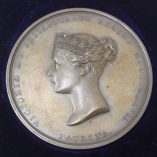
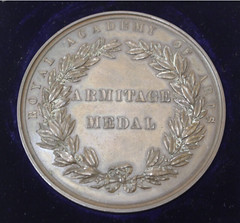
inscribed ‘W.M. Henry Margetson, for design in monochrome for a figure picture’ 10th December 1885, in case
To read the complete lot description, see:
303. A 1885 ROYAL ACADEMY OF ARTS ARMITAGE BRONZE MEDAL
(www.mallams.co.uk/product/303-a-1885-royal-academy-of-arts-armitage-bronze-medal/)
1887 Victoria Golden Jubilee Medal
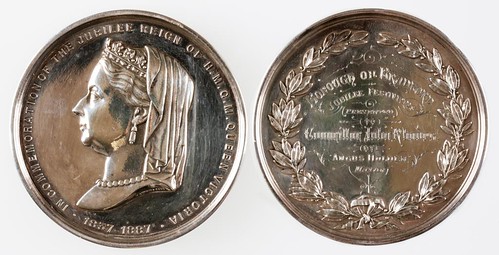
VICTORIA. GOLDEN JUBILEE MEDAL, 1887. Struck in AR, by M. Rhodes and Sons. Obv: Crowned, veiled and draped bust left. Rev: Inscription within wreath "BOROUGH OF BRADFORD / JUBILEE FESTIVITIES / PRESENTED / TO / Councillor John Rhodes. / BY / ANGUS HOLDEN / MAYOR". In original red velvet box, with newspaper cutting "JUBILEE MEMENTO". 76.9g, 58mm dia. AEF.
To read the complete lot description, see:
VICTORIA. GOLDEN JUBILEE MEDAL, 1887. Struck in AR,
(www.dukes-auctions.com/auctions/86/lot/476/VICTORIA.
+GOLDEN+JUBILEE+MEDAL%2C+1887.+Struck+in+AR%2C)
Mozart Medal By Franz Stiasny
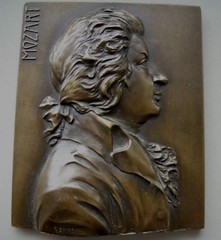
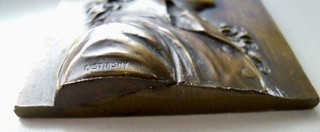
Bronze medal MOZART in beautiful condition - maker Franz Stiasny - 1881-1941 Austria.
To read the complete lot description, see:
88. Bronze medal Mozart - maker Franz Stiasny 1881- 1941
(https://auction.catawiki.com/kavels/10510943-bronze-medal-mozart-maker-franz-stiasny-1881-1941)
1938 German Sudetenland Medal
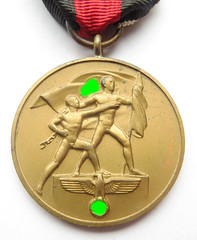
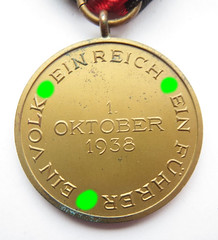
This is a very nice German WW2 Medal:
2nd Medal zur Erinnerung an den 1. Oktober 1938 ", issued in connection with the annexation of the Sudetenland to all German soldiers who were involved in this operation in 1938.
The medal is granted retroactive to halfway the second world war.
Very nice worn condition, on the original Ribbon with hand pin,
Pictures have been photo-shopped. The green dots are not real of course.
Offered from a historical point of view for study purposes to (hobby) historians and/or museums.
To read the complete lot description, see:
141. German WW2 Medal zur Erinnerung an den 1. Oktober 1938.
(https://auction.catawiki.com/kavels/10597037-german-ww2-medal-zur-erinnerung-an-den-1-oktober-1938)
I didn't know what I was looking at first - it seemed like some sort of modern bimetallic art medal. When I read the description I was further confused. "The green dots are not real of course."
Huh? Of course why? Then I thought of what the dots could be hiding, and it finally came to me - swastikas. The Germans are so sensitive about their Nazi past that the symbol adopted by the Nazi party has been banned. Added to the lot description was this disclaimer:
"The objects comprising this lot are meant exclusively for collectors of military-historical objects. The owner of this website does not have any political and/or other motives than providing a platform that allows third parties to buy or sell auction lots, and assumes no responsibility for their contents."
I looked online and found this image of one of the medals. -Editor
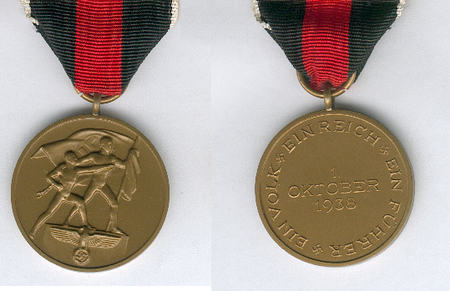
To read the complete lot description, see:
Sudetenland Medal (https://en.wikipedia.org/wiki/Sudetenland_Medal)
1952 Switzerland Schwyzer Kontanal Schutzenfest Medal
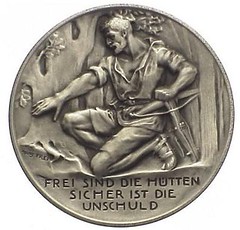
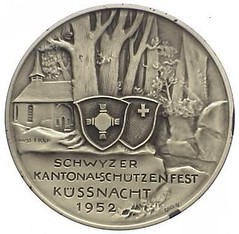
Switzerland. Silver Medal 1952 by Hans Frei Kussnacht Schwyzer Kontanal Schutzenfest. Silver, 42 mm, 29.84 gr. R1110b.
To read the complete lot description, see:
80. Switzerland - Silver Medal 1952 by Hans Frei Kussnacht
Schwyzer Kontanal Schutzenfest (https://auction.catawiki.com/kavels/10582137-switzerland-silver-medal-1952-by-hans-frei-kussnacht-schwyzer-kontanal-schutzenfest)
1917 India India 2 Rupees 8 Annas Banknote
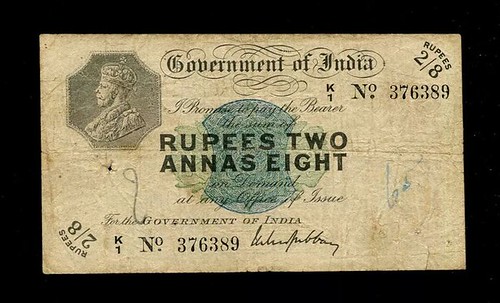
India
Government Of India
1917 Pick 2
2 Rupees 8 Annas
To read the complete lot description, see:
39. India - 2 Rupees 8 Annas 1917 - Issued - Pick 2 - Very Rare
(https://auction.catawiki.com/kavels/10607673-india-2-rupees-8-annas-1917-issued-pick-2-very-rare)

KRALJEVICH ON POGUE COLLECTION, PART V
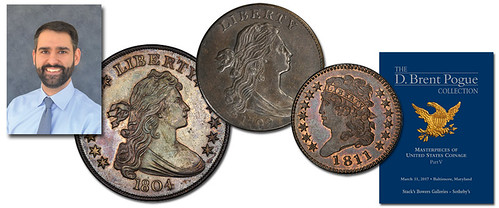
,b> An Appreciation, by John Kraljevich
The D. Brent Pogue Collection, Part V Masterpieces of United States Coinage
For the last two years, most of my numismatic efforts have been concentrated on the cataloging of this magnificent collection. Since these undertakings began, I’ve been reminded consistently of the good fortune I’ve had to get to know so many expert numismatists who have been happy to help, eager to share stories, and generous in offering access to their libraries and their memories. Along with a research library that has been dutifully assembled over the course of three decades, these relationships have been the sine qua non of writing the Pogue catalogs.
Half cents and large cents, collectively termed “early American copper,” compose the bulk of the present sale. They’ve also been the series that have most captured my attention over the course of my numismatic life. From the time that I was combing the flea markets of Pennsylvania for them as a boy, large cents have quickened my pulse more than any other series of United States coinage. While silver can take on a spectrum’s range of toning, and gold has a liveliness all its own, there is no other coining metal with as wide a span of inherent variation and beauty as copper. The sedate gloss of a well worn cent may not match bright red luster in most collectors’ estimation, but to those drawn to the coppers above all else, each has a distinctive appeal.
Beyond visual attractions, no other series has as long and storied a past as do the early coppers. Coin collecting as we know it in this country literally owes its existence to the large cent. Just as the disappearance of silver from the tills of stores from Boston to Berkeley presaged an overwhelming growth of interest in coin collecting in the 1960s, so too did the end of the large cent’s reign over pockets and countertops. The lowly cent became the coin that unified a nation of collectors in the late 1850s and the decades that followed. Before long, the finest of cabinets was defined by the finest of cents. The humble had become the most exalted.
Before large cents had stopped circulating, a handful of collectors realized that cents dated 1793 could depict a chain, a wreath, or a liberty cap, variety collecting has been an unstoppable force in the world of early copper. Date collections had been assembled for years before, and even today a collection of dates ranks high on many collectors’ to-do lists. But collecting by die variety has been the heart and soul of cent collecting since nearly its beginning. The Crosby-Levick plate started the trend in 1869, identifying 15 different combinations of obverses and reverses of 1793 cents.
By 1947, the works required to attribute the first decade of large cent production filled a shelf: Sylvester S. Crosby’s 1897 work on the cents of 1793 (S.S. Crosby, 1897), two books on 1794s (Frossard-Hays, 1893 and S.H. Chapman, 1926), another on the cents of 1795 through 1797 and 1800 (George H. Clapp and Howard Newcomb, 1947), one more for 1798 and 1799 (George H. Clapp, 1931), and a reference on the cents of 1801 through 1803 (Newcomb, 1925). Frossard (1879) and Doughty (1890) covered the whole series, though neither was regarded as complete in its listings or user-friendly in its execution. Still, collectors flocked to the series, and rare die varieties were avidly pursued.
And then came Sheldon. In 1949, Dr. William Herbert Sheldon published Early American Cents. Its title page announced the collaboration of Homer K. Downing, the noted New York collector, and M.H. Sheldon, who typed the manuscript; M.H. stood for “my hands.” Sheldon, who bid with the code name “Jester” in the 1952 sale of Downing’s collection, also gave credit to Horatio and Hazard Sheldon, “who assisted with spirit.” Horatio and Hazard were the author’s typewriters. Sheldon blended a scientist’s precision with a storyteller’s playful and passionate enjoyment of the subject matter, creating a work that changed the world of numismatics far beyond the specialty about which he wrote. Sheldon invented the numerical grading standard that remains at the heart of the hobby and industry today, and his rarity scale has likewise endured nearly universally. It is certain that a book written about any other specialty but the early cents could not have produced the same pebble-in-a-pond effects as Early American Cents and its 1958 second edition Penny Whimsy did, but perhaps no author but one with Sheldon’s raconteurial gifts could have defined concepts and evoked emotions that remain so powerful today.
There is no field of American numismatics that has passed along an institutional memory and oral tradition like large cents. Many of the specialists alive today learned their love of these cents from the founding generation of the Early American Coppers Club (EAC). That generation knew Dr. Sheldon, and Dorothy Paschal, and C. Douglas Smith, and Willard C. Blaisdell and Ted Naftzger, the men and women who dominated cent collecting in the 1950s and 1960s. Those collectors knew Homer Downing and George Clapp and Henry Hines, who knew Howard Newcomb and S. Hudson Chapman and David Proskey. Just one more step into the past puts us face to face with the founders of American cent collecting: William Wallace Hays, Dr. Edward Maris, Charles Steigerwalt, Ed Frossard, and their mentors Sylvester Crosby, J.N.T. Levick, and Joseph J. Mickley, whose curiosity about finding a cent of his birth year presaged nearly all cent collecting that followed.
I was born two weeks after most large cent collectors got the news via Penny-Wise, the mouthpiece and heartbeat of the Early American Coppers club then and now, that Dr. Sheldon had passed away. Dr. Sheldon, who believed that genetics defined a human’s intellect and emotional state more than any other force, might have said that I was a collector even as we co-existed, he as an infirm man of nearly 80 years, me as a fetus. The generation that I learned from, that taught me to grade cents, to study their eye appeal and their provenance, and to cherish their importance and history, was the generation that learned from Dr. Sheldon himself. More than a few of my copper mentors sat next to Dr. Sheldon, at the now legendary windowsill overlooking New York’s Riverside Drive, as he explained the intricacies of numerical grading and regaled them with stories of Hines, of Downing, of Newcomb and Chapman and Proskey.
The stories, passion, etiquette, and fraternity that surround the large cents descended in a direct person to person string from the 1850s to today, creating a numismatic community like few others. It persists when copper collectors gather around a velvet tray and a bottle of scotch, but also on an online forum or a convention floor. There is something special about these coins and the people who are drawn to them and I feel incredibly fortunate to have learned my craft while sitting at their feet. From the time I was hardly tall enough to peer into their exhibit cases, copper specialists have taken the time to share their stories and cents with me, particularly within the friendly confines of meetings of the Early American Coppers club. My efforts are offered with thanks to them.
A team of numismatists and others at Stack’s Bowers Galleries have gathered to make this effort possible. James McCartney lent his cataloging talents to many of the Seated coins, his first work on the Pogue franchise. John Pack, with his excellent work on the Twin Leaf Collection barely cleared from his always-busy desk, cataloged the middle and late date cents herein, dutifully tracking provenance with uncommon care. Without John’s research assistance, much of which came at what would be indecent hours were it not for the bicoastal time difference, this project would look much different. My wife, Megan, managed to keep me sane during months of writing, caring for boys and animals while I hid behind stacks of dusty books. Like everything else I do that’s worthwhile, I couldn’t have written this without her.
The research in this and earlier Pogue catalogs was developed from decades of work by earlier authorities. The mistakes are all my own.
Apple MacBookPro Kraljevich assisted with spirit.
John Kraljevich
Fort Mill, South Carolina
January 2017
To read the complete article, see:
An Appreciation, by John Kraljevich The D. Brent Pogue Collection, Part V Masterpieces of United States Coinage
(www.stacksbowers.com/News/Pages/Blogs.aspx?ArticleID=2458)
SELECTIONS FROM THE POGUE COLLECTION, PART V
Lot 5001: The Pittman Proof 1837 No Stars Half Dime
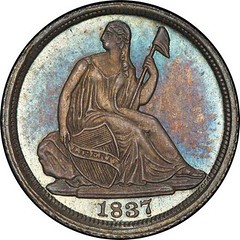
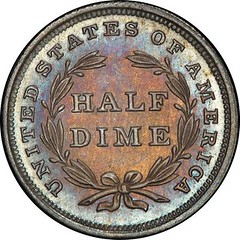
The devices are executed perfectly in this tiny jewel-like form, thanks to the technological advances of the reducing lathe introduced at the Mint following Franklin Peale's trip to study innovations in European mints. The human impact upon the dies that struck this coin was little beyond punching in the date digits. This personal touch is reflected upon examination under magnification. Each individual date punch was punched too low, with 1, 3, and 7 on more or less the same line while the 8 actually overlapped with the denticles below. Correcting this error meant effacing most of the earlier digits, but not their bases, which remain. The die rotation, also set by human hands, shows the reverse to be a few degrees left of proper coin turn.
After the Liberty Seated design was introduced on the dollar denomination in 1836, it was shrunk to size for the half dime and dime denominations in early 1837, followed by the quarter dollar in 1838 and the half dollar in 1839. The half dime, the smallest showcase of the Gobrecht design, was first struck on July 25, 1837. "I have the pleasure to send you herewith 20 half dimes of the new emission," Mint Director Robert Maskell Patterson wrote to Treasury Secretary Levi Woodbury that day. "You will see that they are fair similes of the new dimes." Walter Breen suggested that all 20 pieces were Proofs, though the letter does not specify. PCGS has certified an 1837 Proof on 10 occasions, though this figure is undoubtedly greater than the number of discrete specimens they've seen.
To read the complete lot description, see:
The Pittman Proof 1837 No Stars Half Dime (https://auctions.stacksbowers.com/lots/view/3-6QPQ6)
Lot 5011: The W.W. Neil - Pittman Gem 1837 No Stars Proof Dime
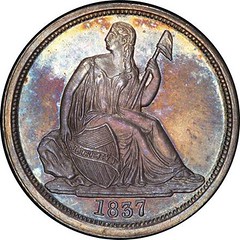
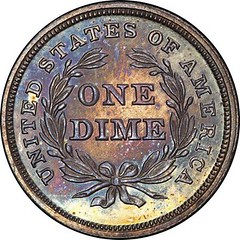
Research by John Dannreuther has found that Proof 1837 Seated Liberty dimes were struck on three occasions with three discrete die alignments. One he measures as 20 degrees clockwise, as seen here, is found on those coins struck from the earliest state of the dies and represents the very earliest production of Proof dimes of this design type. Other recognized rotations are proper coin turn and a slight twist, roughly 10 degrees, counterclockwise. Dating the production of the first 1837 No Stars dimes remains challenging. Breen frequently mentions, without citation, a letter delivering 20 new dimes dated June 30, 1837; this missive has evolved between his 1950s publications to those in the 1980s from a letter presenting new dimes to an order that "the newly completed Gobrecht dies ... be placed into the dime press" to create "some 30 brilliant proofs ... for presentation to Treasury officials and other VIPs." A July 25, 1837 letter presenting a small group of new half dimes to the Treasury Secretary does mention that dimes had already been produced and calls the new half dimes "fine similes of the new dimes." The June 30, 1837 date for initial distribution of new dimes is likely correct, and those new dimes could well have been Proofs, but confirming either of those likelihoods as facts is perhaps impossible.
Were it not for the reducing lathe technology that Franklin Peale brought to the Philadelphia Mint after 1835, it would have been well nigh impossible to create such a diminutive example of Christian Gobrecht's enduring No Stars design. The hubs for Seated Liberty dimes such as this were made in perfect proportion to their dollar progenitors, then delicately touched up by Mint engravers. The process was well described in the December 1861 issue of Harper's New Monthly Magazine in an article by Waldo Abbott that was later serialized in Mason's Coin and Stamp Collectors Magazine in 1870:
Look at the bas relief of Liberty on one side of a coin. It would be exceedingly difficult to design this in hard steel and of so small a size; so they first make the design in wax, probably six times as large as the coin, by which means the beautiful proportions can be obtained. From this a brass cast is taken and reduced on steel to the size of the coin by a transfer or reducing lathe. This ingenious instrument was introduced from France by Mr. Peale, who also operated it for some time.
To read the complete lot description, see:
The W.W. Neil - Pittman Gem 1837 No Stars Proof Dime (https://auctions.stacksbowers.com/lots/view/3-6QPRC)
Lot 5038: The Amon Carter 1801 Dollar
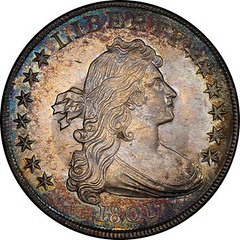
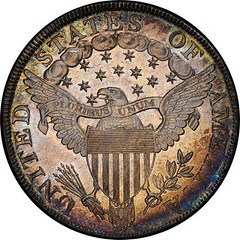
The Amon Carter collection's assemblage of early dollars is the stuff of numismatic legend. Most of the coins were acquired in the 1940s, particularly from Carter's Fort Worth friend and neighbor B. Max Mehl. The introduction to the Carter dollars in the January 1984 Stack's catalog notes, "the vast majority of the coins" came from Mehl's 1947 W.W. Neil sale and his 1950 Golden Jubilee auction. This piece unquestionably came from the latter, where lot 797 was a specimen of this die variety described as "Brilliant Proof" with "a peculiar halo or shadow around the bust."
Mehl went on to note the coin was "as beautiful a specimen of the early silver dollar of any date that has ever come to my attention" and traced its provenance to the Colonel Green Collection for the substantial sum of $100. While unplated, there is simply no other specimen of this variety that closely resembles this coin or Mehl's description. For that matter, no other 1801 dollar of any variety compares to this one. The sole other MS-65 (PCGS) coin is a BB-212, frosty rather than prooflike, beautiful but considerably different in its appeal. That coin, perhaps unsurprisingly, also traces its provenance to the Col. E.H.R. Green Collection.
To read the complete lot description, see:
1801 Draped Bust Silver Dollar. Bowers Borckardt-214, Bolender-4. Rarity-4. (https://auctions.stacksbowers.com/lots/view/3-6QOVK)
Lot 5054: The Harlan Page Smith 1805 C-1 Half Cent
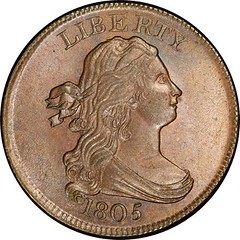
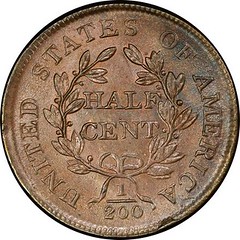
Though half cent collectors cherish provenance, very few half cents offer a chain of ownership that extends over a century. This example traces its lineage to the personal collection of legendary dealer Harlan Page Smith, half of the partnership that offered the collections of Lorin G. Parmelee, Robert Coulton Davis, and George D. Woodside, among others, as New York Coin & Stamp Company. Smith and David Proskey joined forces in 1888, following Smith's brief business arrangement with H.G. Sampson and nearly a decade cataloging and auctioning collections on his own. The most famous of his solo sales offered the cabinet of Dr. Edward Maris, the Philadelphia physician whose name remains synonymous with the New Jersey copper varieties he described in an 1881 monograph.
Smith died March 2, 1902, at home on West 52nd Street in New York City, next door to the modern Neil Simon Theatre between Broadway and 8th Avenue. His obituary, penned by Lyman Low and published in the American Journal of Numismatics, reports that he was born Upstate in 1839 and spent his youth as a mariner "roving over distant parts of the world." A career as a fruiterer followed, but in 1876 he retired to devote himself to his love of numismatics full time. Low noted that Smith "was always credited with good judgment" and "proved a bold operator" due his extensive knowledge of coins. "Quick to discern pieces of special rarity or value," Smith socked this half cent away for his own cabinet, recognizing it as perhaps the best, or at least one of the best, he had seen.
To read the complete lot description, see:
1805 Draped Bust Half Cent. Cohen-1, Breen-1. Rarity-2. No Stems. (https://auctions.stacksbowers.com/lots/view/3-6QOPX)
Lot 5074: The Garrett 1831 Reverse of 1836 Half Cent
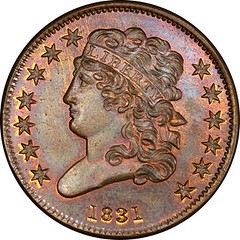
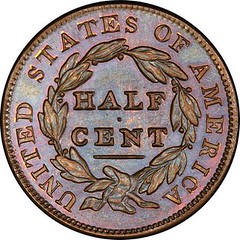
There is likely no such thing as an 1831 circulation strike half cent, though a somewhat worn piece in the Missouri Cabinet was assigned a grade of AU-55 by PCGS. Instead, there are three varieties of Proofs that collectors can choose among to own an example of this date. Original 1831 half cents, struck in Proof finish in 1831, are extreme rarities, with perhaps a dozen known. The 1831 half cents with the reverse type of 1840 were coined much later, perhaps as late as the 1870s, and are also extremely rare. Just five are known, including the specimen in the next lot. Most date collectors end up acquiring an example like this, if they ever find one at all. The 1831 First Restrikes use a reverse from 1836 and were likely coined in the late 1850s, when interest in United States copper coins first began to blossom.
There may be as many as three dozen 1836 First Restrikes known, most somewhat handled. Rick Coleman identified 32 provenance chains in the pages of Penny-Wise, but the listing for this coin was actually for two different specimens that looked remarkably similar. Others appear not to have made the list at all, including the example offered as lot 2112 in the June 2004 Medio sale by Stack's and American Numismatic Rarities.
This appears to have the oldest provenance of any 1831 First Restrike currently traced. Coincidentally, it is also one of the first struck, coined from a perfect state of the dies with neither swelling nor the crack that bisects the reverse in later states. Coleman's research found 20 early die state pieces. The only other specimens that Coleman was able to trace to before World War I are the New York Public Library coin (donated by Thomas Addis Emmet in the late 1880s), the Gschwend coin that was sold as part of Auction '80, and the Eliasberg coin that John H. Clapp had acquired at the 1904 Mills sale. This coin, purchased by T. Harrison Garrett before his demise in 1888, was among those deaccessioned by Johns Hopkins University in 1976 to be sold by Stack's. It appears to have sold publicly just twice since.
To read the complete lot description, see:
1831 Classic Head Half Cent. First Restrike, Reverse of 1836. Breen 1-B. (https://auctions.stacksbowers.com/lots/view/3-6QP1Z)
Lot 5096: Helfenstein 1794 Sheldon-26 Large Cent
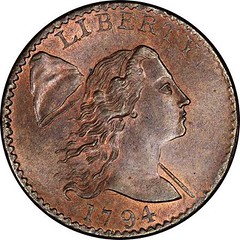
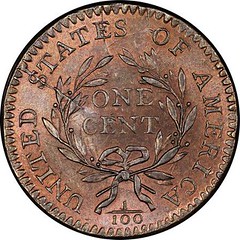
This cent found its way to Louis Helfenstein in the late 1950s or early 1960s, soon after it first emerged from the woodwork. Those years after the publication of Penny Whimsy were an era of significant change within the close knit large cent community. The men of the pre-war generation had passed: Hines, Newcomb, Wurtzbach, Clapp, T. James Clarke, Homer Downing, and others. The marketplace for cents, both in terms of collector interest and available information, had changed enough that the initial edition of Dr. Sheldon's book, Early American Cents, required substantial updating, which Sheldon undertook with two new co-authors, Walter Breen and Dorothy Paschal.
C. Douglas Smith, who sold this coin to Helfenstein about 1960, described his late friend in some detail in the July 1978 issue of Penny-Wise.
Lou right away got interested in collecting large cents, and he early decided to collect just the top quality large cents. As far as prices went, he just decided to buy any coin he liked and the heck with the price, and he had enough money to do it. In a very few years, he formed an excellent collection because he only bought Mint State coins. At that time, he would pay more than most people and he had pretty good opportunities because he was right in New York.
Helfenstein's approach did not sit well with everyone, including Dr. Sheldon's co-author and close friend, Mrs. Paschal. "Helfenstein was not a collector in my opinion - he was merely a speculator who started buying gem coins a few years ago - half a dozen years or so," Paschal wrote in 1964 to contemporary collector Dr. Robert Carter. Lester Merkin's catalog was groundbreaking: it was the first to use color photography, the first to photograph nearly every lot, and the first to use the sort of artful cover layout that would become de rigeur of most numismatic auctions in later decades. Still, the novelty of it perturbed Paschal and many of her contemporaries.
To read the complete lot description, see:
1794 Liberty Cap Cent. S-26. Sheldon-26. Head of 1794. Rarity-2. (https://auctions.stacksbowers.com/lots/view/3-6QP7U)
Lot 5106: 1797 Cent from the Nichols Hoard
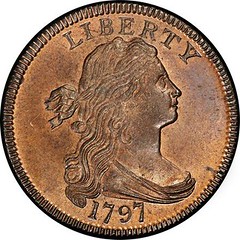
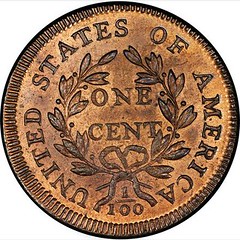
The coins of the Nichols Find trace their lineage to David Nichols of Salem, Massachusetts, who lent his name to a small group of Mint State cents dated 1796 and 1797 that were in his possession. Nichols lived near Gallows Hill, made famous by the unsavory aftermath of the Salem Witch Trials, and died in Salem in 1882 at the age of 72. In comments to the April 1917 meeting of the Boston Numismatic Society, published in The Numismatist in August of that year, John Robinson recalled his days as a young collector living nearby.
David Nichols, living near Gallows Hill, would occasionally open the bag of mint-bright cents of 1796 and 1797 and give us one of each. The lot came, it was said, from the Hon. Benjamin Goodhue, who received them in part pay for his services in the U.S. Senate. As I remember them at the time there were about 50 or 60 of each date in the bag.
W. Elliot Woodward, the Roxbury coin dealer and druggist whose writings made him a window into the numismatic world around Boston from the 1860s through 1890s, corroborated Robinson's story in his January 1882 sale. "When I first saw these cents, they were kept in a bag in which Benj. Goodhue, the grandfather of Mrs. Nichols, brought them from Philadelphia in 1797."
Oral history is an excellent but imperfect source, often grasping the heart of a story without mastering all the particulars.
To read the complete lot description, see:
1797 Draped Bust Cent. Sheldon-135. Reverse of 1797, With Stems. Rarity-3+. (https://auctions.stacksbowers.com/lots/view/3-6QP9Z)
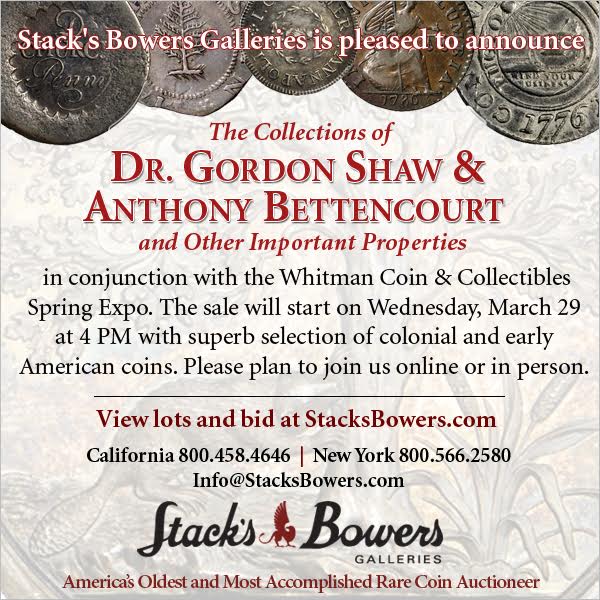
BUILDING THE LILLY COLLECTION, CONTINUED
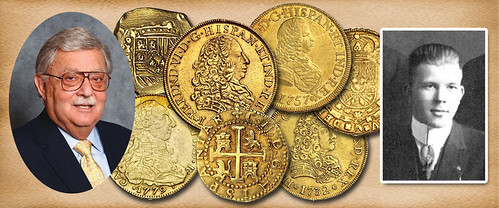
Sometimes forces interfere with a collector’s desires and plans that are not in the collector’s control or even in the control of the hobby. This happened during the time frame when Stack’s was instrumental in building the J.K. Lilly Collection. During the post-World War II years and even into the 1960s, some gold coins issued were found to be counterfeits.
Demand for gold for various reasons led to an industry developing overseas after the Second World War. Places like Milan and Florence in Italy, and Beirut in the Middle East, copied the designs of many popular gold coins and sold them to unknowledgeable collectors, tourists and the jewelry industry at a substantial profit above the intrinsic value of the coin. As the demand increased, so did the shipments made to the United States; the supply seemed endless. The American market was being ripped off because many buyers did not know the difference. The designs were so well reproduced that the coins were bought and sold as if they were genuine. Thousands of people were being fooled. Since the United States Secret Service was busy with counterfeit paper currency and received complaints only after the false coins were discovered, enforcement was difficult.
To help stop the importation of counterfeit coins, in 1960 the Office of Gold & Silver Operations (OGSO) was empowered to try to stop the false coins before they entered the United States. The OGSO started a licensing procedure, requiring a license to import gold coins, issued by that Department of the U.S. Treasury. Before a gold coin could be carried into the United States or received in this country by mail, it had to receive a license. From day one the procedure caused delays, and loss of sales, but it was somewhat effective in stopping the importations. However it was burdensome and restrictive to all involved.
Buying a gold coin from overseas became a much more difficult project. Collectors needed to know if they could get a license to bring their purchases into the United States before they bought coins. If they purchased coins before having a license, they could be denied and the coins could not be brought into the country. How could buyers know what would be admitted? Hand-carried packages were examined and sometimes confiscated and held at customs houses if there was not an appropriate license. Items that came by mail could be held at the post office. While the importation of counterfeits was slowed -- a good thing for all -- the burden on collectors and the numismatic hobby was great. A collector, seeing a coin in a price list or auction, had to ask the seller to hold it until a license could be acquired. It was virtually impossible to get a supply into the country.
This made it difficult to add to a collection such as the one that J.K. Lilly was trying to build. In one particular instance Stack’s ran up against these licensing difficulties when a large numismatic gold coin collection was offered to the firm in 1962. The collection, comprising over 900 different coins of the world, would require months to get the appropriate license. Stack's finally lost the opportunity to offer it at public auction, since the consignor was sick and would not wait.
The loss of this overseas collection, together with other business problems resulting from the license requirement caused Stack's to sue. The problem was that the rules defining what could or would be licensed were never revealed by the OGSO, but the decisions were made at their sole discretion. Stack's sued that the OGSO licensing requirements were Arbitrary and Capricious because they kept their rulings to themselves. Being a government agency the OGSO made the determinations on their own. It took till 1967 to win the case. A member of the Treasury Department announced the removal of the licensing requirements at a PNG meeting, explaining, “the intent of the law had been satisfied”
The restrictions did great harm to coin collecting and even to jewelers. However, at Stack’s we always did our best to meet the needs of our clients, including Mr. Lilly.
To read the complete article, see:
Building a World Class Numismatic Gold Coin Collection: The Josiah K. Lilly Collection Part 22
(www.stacksbowers.com/News/Pages/Blogs.aspx?ArticleID=2450)
To read the earlier E-Sylum article, see:
BUILDING THE LILLY COLLECTION, CONTINUED (www.coinbooks.org/v20/esylum_v20n05a17.html)
GLENNA GOODACRE SCULPTURAL WORKS FOR SALE
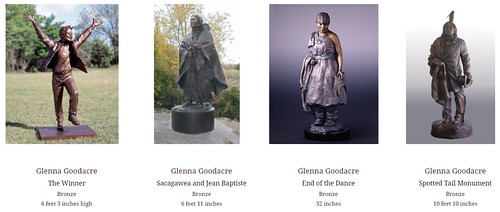
Dick Johnson writes:
Collectors can add a Glenda Goodacre item to their collection but it won’t fit in you album next to your Sacagewea Dollars. It’s sculpture. Some of which are eight feet high. Here’s the notice from the National Sculpture Society. Don’t overlook the video from the Scottsdale Art Auctions, which are selling her studio collection April 6.
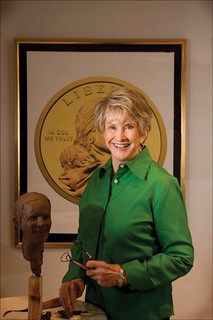 In April, Glenna Goodacre will have a special auction of her sculpture. The sculptor, whose body of work runs from the monumental (Vietnam Women's Memorial) to medallic (Sacagawea U.S.
Dollar Coin), is allowing the public a chance to bid on over 100 items from her personal collection of art. Goodacre formally retired in the fall and donated a large portion of her studio
accessories, books and four sculptures to the New Mexico School for the Arts in Santa Fe. As for the upcoming auction, Goodacre says "It’s an interesting new chapter in my life and I wanted to
create a fun, exciting event for me and for the many collectors who enjoy my art."
In April, Glenna Goodacre will have a special auction of her sculpture. The sculptor, whose body of work runs from the monumental (Vietnam Women's Memorial) to medallic (Sacagawea U.S.
Dollar Coin), is allowing the public a chance to bid on over 100 items from her personal collection of art. Goodacre formally retired in the fall and donated a large portion of her studio
accessories, books and four sculptures to the New Mexico School for the Arts in Santa Fe. As for the upcoming auction, Goodacre says "It’s an interesting new chapter in my life and I wanted to
create a fun, exciting event for me and for the many collectors who enjoy my art."
The auction is scheduled for April 6 and will be handled by Scottsdale Art Auction.
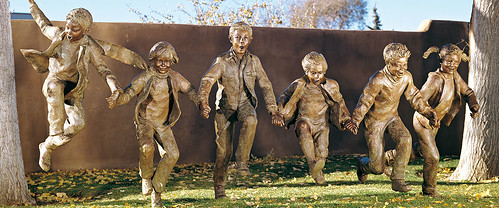
"Puddle Jumpers"
for more information, see:
http://glennagoodacreauction.com/
To watch the video, see: https://youtu.be/ysRdOeO1lNw

KUSHAN DYNASTY COINS BAFFLE EXPERTS
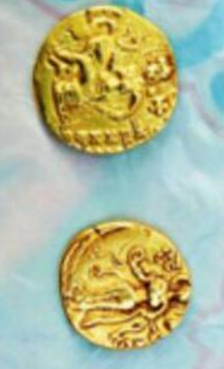 The mystery over the excavation of gold coins at a village in Jankipura in Tonk has become deeper with the recovery of two coins and a terracotta bull dating back to Kushan dynasty and
first century AD.
The mystery over the excavation of gold coins at a village in Jankipura in Tonk has become deeper with the recovery of two coins and a terracotta bull dating back to Kushan dynasty and
first century AD.
The State Archaeology and Museum Department (SAMD) has prepared a report after examining 108 gold coins, recovered from the villagers till January 17, with images and inscriptions in Greek and Brahmi language.
The report was prepared after the experts deciphered the Greek and Brahmi script as per international archaeological standards.
Initial observations had found that the gold coins date back to the period of Gupta dynasty. However, the new study has revealed that 106 coins belong to the period of three Gupta emperors—Samudragupta (335-380 AD), Chandragupta II (380-415 AD) and Kumaragupta (415-455 AD)—while two were from the Kushan dynasty.
Numismatists are puzzled and have not yet solved the mystery of how these gold coins, which are 500 years apart, have been found in one place.
"The Kushan coins have an image of a king giving 'ahauti' (inflamable item) to the fire on one side. On the other side, there's an image of Greek god and goddesses," said Jafarullah Khan, circle superintendent, SAMD, Ajmer circle, who prepared the report. Inscriptions on the coin in Greek read: 'Shao Nano Shao, Kanishka Kushan (Emperor of the emperor, Kanishka Kushan).
The Gupta period coins have images of god and goddess, 'veena', peacock, chair, etc., and inscriptions in Brahmi language. "The rarest coin from the Gupta dynasty period is that of a goddess sitting on a chair with the hair falling down over the shoulder. She wears a sari. The words describe her as a goddess and speaks about independence and empowerment of women back then," he said.
To read the complete article, see:
Kushan dynasty coins found in Tonk village baffle
experts (http://timesofindia.indiatimes.com/city/jaipur/kushan-dynasty-coins-found-in-tonk-village-baffle-experts/articleshow/57484211.cms)
THE NETHERLANDS: “LION DAALDER” REBORN
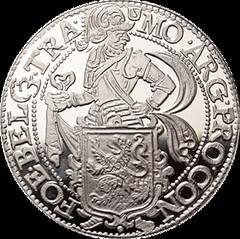
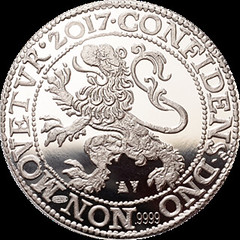
The Royal Dutch Mint have unveiled their newest silver and gold 1-ounce coins, which are based on one of the world’s most well-known and trusted trade coins of the late 16th century. The famed lion daalder (or leeuwendaalder) was first minted by the Province of Holland in 1575 as a means of increasing trade between their many trading ports and outposts from Asia to the Americas, from Africa to Australia, and everywhere in between. However, these very coins were themselves based on an even more popular and well-known coin: the Joachimsthaler of Bohemia, minted from 1519. It was important for the new Dutch provincial coin (whose very name, daalder, was a derivative of the word “thaler”) to resemble closely these well-known coins so Dutch traders could benefit from the popularity and trust enjoyed by Joachimsthalers, both locally and internationally. Early daalders were cut out of silver planchets that were not perfectly round and were relatively thin, so their strike was not very detailed and the image on both sides was less visible than hoped for. In time the coins improved in quality as well as in reputation.
With a weight of 26.79 grams of .750 fine silver, the lion daalder was also popular in the Dutch East Indies as well as in the Dutch New Netherlands Colony (present-day New York). After the British became the dominant power in the New World, the lion daalder remained in circulation with a recognised value of 4 shillings and 6 pence. Besides the popularity of the Spanish “piece of eight” (or 8-reales silver coin), which also widely circulated in the United States from the late 1700’s, it is unmistakable that the lion daalder greatly influenced the American silver coinage—especially the name of the new country’s currency, the dollar, which was first minted in 1794.
During the mid-17th century, the leeuwendaalder became so widely used and recognised worldwide, it pushed many local coins out of their own markets. Aside from the Balkan countries, the lion daalder was the standard form of commerce in regions and states such as Anatolia, Syria, Egypt, and Northwest Africa for over a century. It was not until 1713, when the leeuwendaalder was no longer minted, that it was finally surpassed by the Maria Theresa thaler from 1751 onwards. Despite their lack of production, the leeuwendaalder remained legal tender for some time in the Levant.
The Royal Dutch Mint’s first modern lion daalder restrikes are based on the design originally issued in Utrecht in 1617, and mark the 400th anniversary of this particular provincial issue. Included on the obverse is a standing knight. In front of his legs rests a shield bearing a lion in what is known as the rampant position. (This lion is found on both the Dutch and Belgian coats of arms.) Within two circles of beadwork around the rim is the legend MO. ARG. PRO. CONFOE. BELG.—short for MONETA ARGENTEA PROVINCIARUM CONFOEDERATUM BELGICARUM, or “silver money of the Province of the Netherlands”—followed by the letters TRA (representing Utrecht).
The reverse displays the same heraldic lion in a larger size, and as with the obverse design it has two circles of beadwork around the rim enclosing a legend—in this case, the date of issue, 2017, and the motto of the United Provinces, CONFIDENS. DNO. NON. MOVETVR, or “Who trusts in the Lord is not moved” (“DNO” is an abbreviation of “Domino,” or “Lord”).
To read the complete article, see:
The Netherlands: “Lion daalder” reborn in new gold and silver bullion coins
(http://news.coinupdate.com/the-netherlands-lion-daalder-reborn-in-new-gold-and-silver-bullion-coins/)
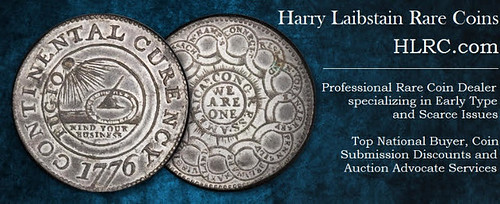
STOLEN BANKNOTE RETURNED 30 YEARS LATER
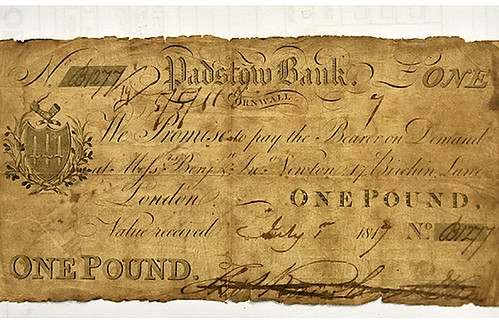
Museum staff were stunned when a 200-year-old bank note was returned decades after it was stolen.
The ancient currency was sent hundreds of miles from the West Indies to the Padstow Museum in Cornwall.
It was stuffed in a white envelope dotted with colourful Caribbean stamps - but had no return address.
The enevlope contained a rare 200-year-old Padstow Bank £1 note stolen from the museum more than 30 years ago.
"The note was issued by the Padstow Bank of Thomas Rawlings in 1819 and I knew we had a note like that in the collection.
"So I got out my book and my magnifying glass and checked the note I had been sent with the one in he book about the museum which was published in the 1970s. It was the same note.
Mr Buckingham was aware the note had been reported as stolen from the museum in June 1984.
John said: '"I'm just very pleased that the note is back at the museum. It's important that it is back at the museum at last."
The note is a relic of Regency era Padstow and at the time would have been a sizeable sum of money.
Housemaids earned around £7 a year and unskilled labourers and fishermen in the harbour earned far less.
The note will be available to view when Padstow Museum reopens at Easter.
To read the complete article, see:
Incredibly rare bank note handed in by
mystery person years after being stolen (www.plymouthherald.co.uk/incredibly-rare-bank-note-handed-in-by-mystery-person-years-after-being-stolen/story-30183119-detail/story.html)
DEMAND CONTINUES FOR SPECIAL FIVE POUND NOTES
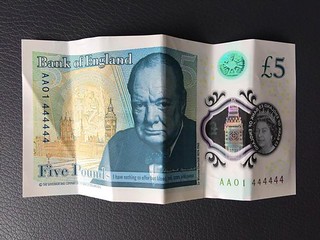 A rare £5 note has sold online for more more than £60,000.
A rare £5 note has sold online for more more than £60,000.
The fiver, one of the new polymer notes introduced by the Royal Mint in September, features the serial number AA01 44444 - meaning it was one of the earliest to be printed.
The banknote went up for auction on eBay last week, with 21 bidders placing 136 bids.
The winning bid stood at £60,100 when the auction closed earlier today.
The new plastic fivers, featuring Sir Winston Churchill, were introduced to combat counterfeiting.
Since entering circulation, the plastic banknotes have become a highly sought after prize among currency collectors, with the low serial numbers fetching the highest amounts.
To read the complete article, see:
Rare plastic £5 note sells for more than £60,000 on eBay as market for unusual fivers spirals
(www.mirror.co.uk/news/uk-news/rare-plastic-5-note-sells-10012253)

